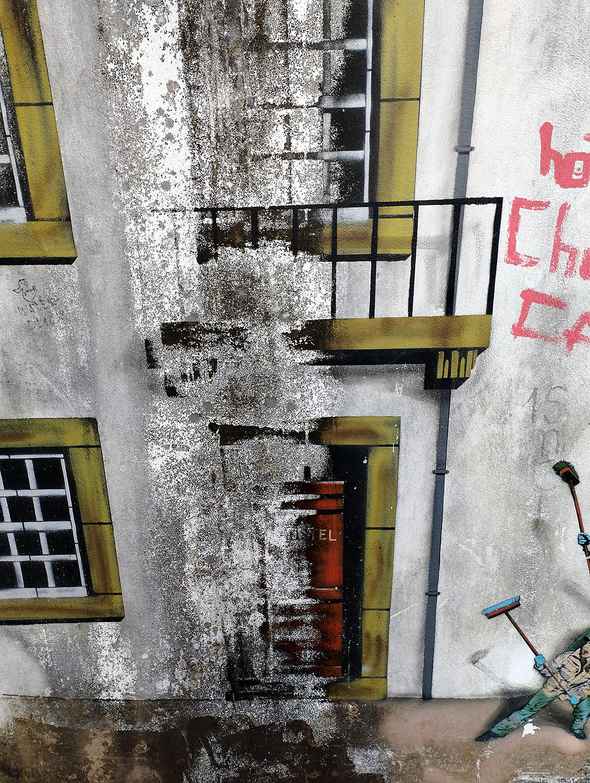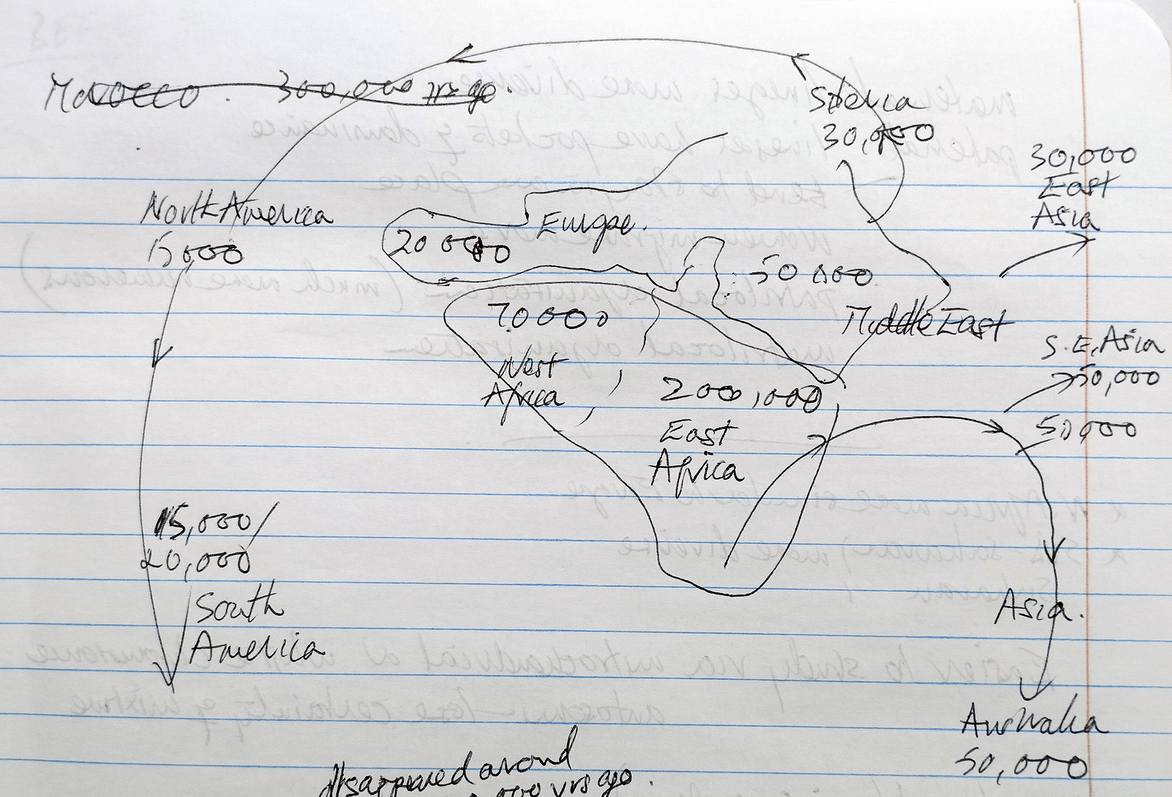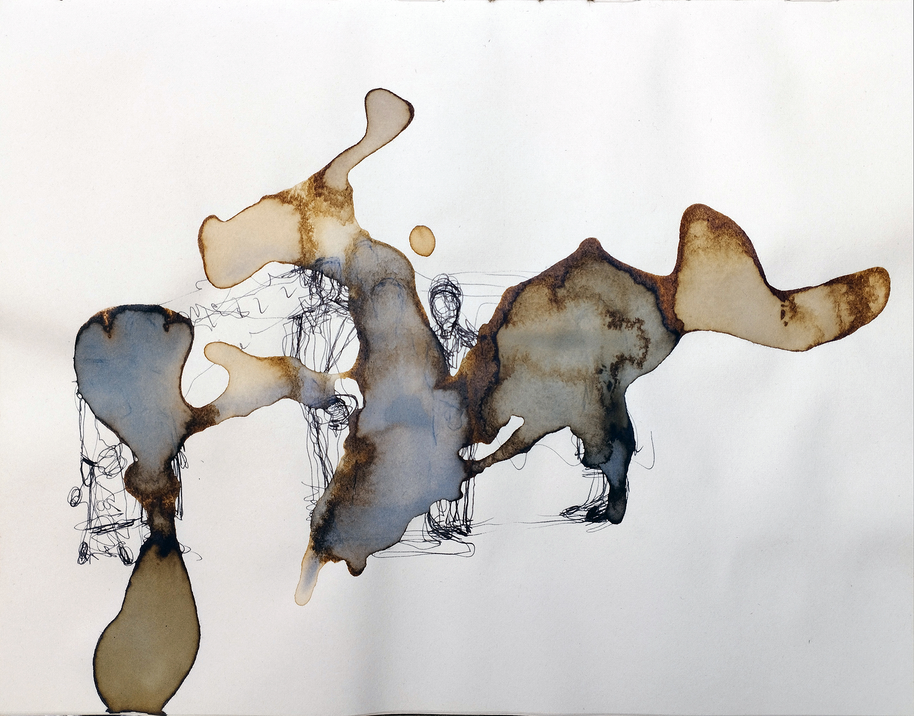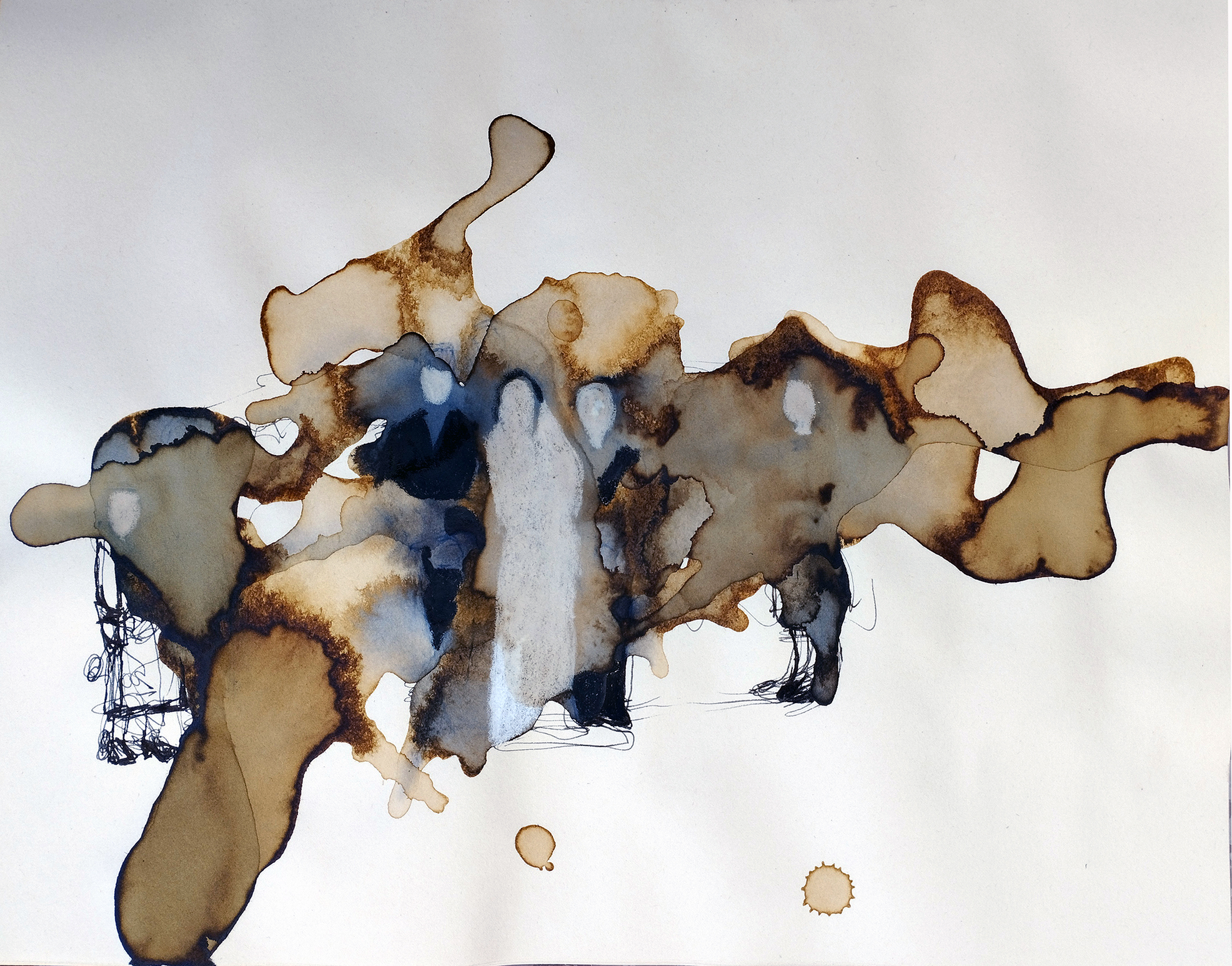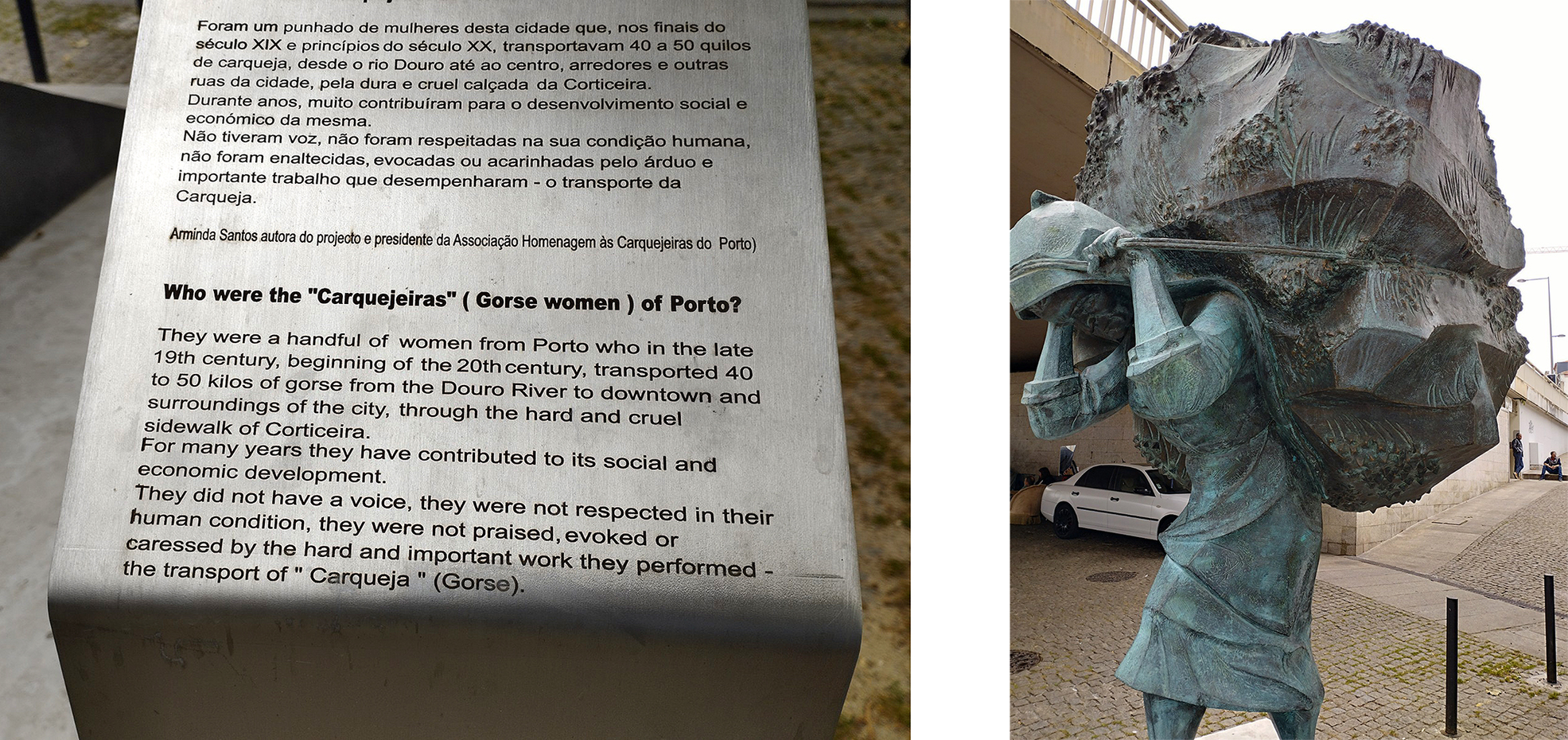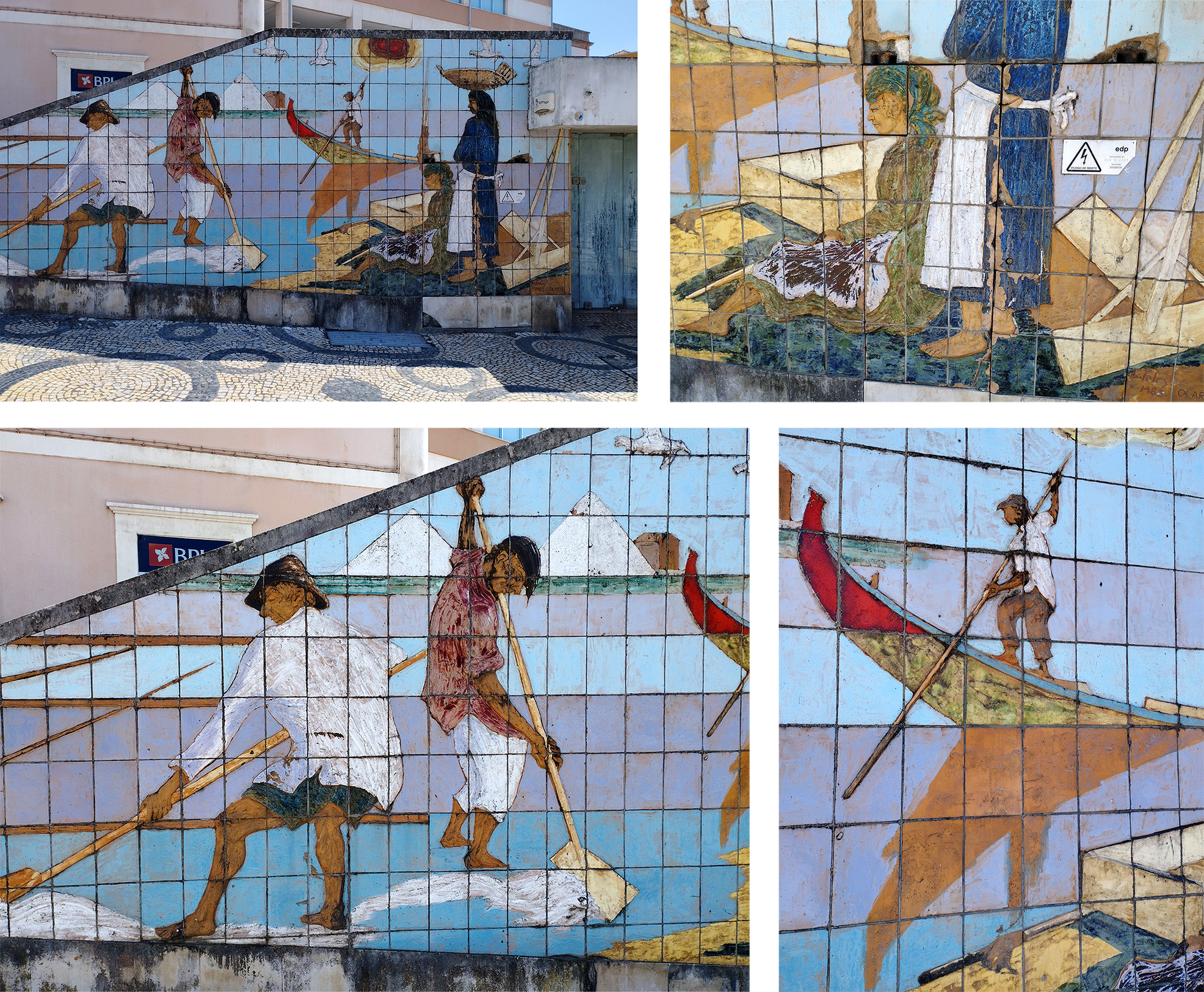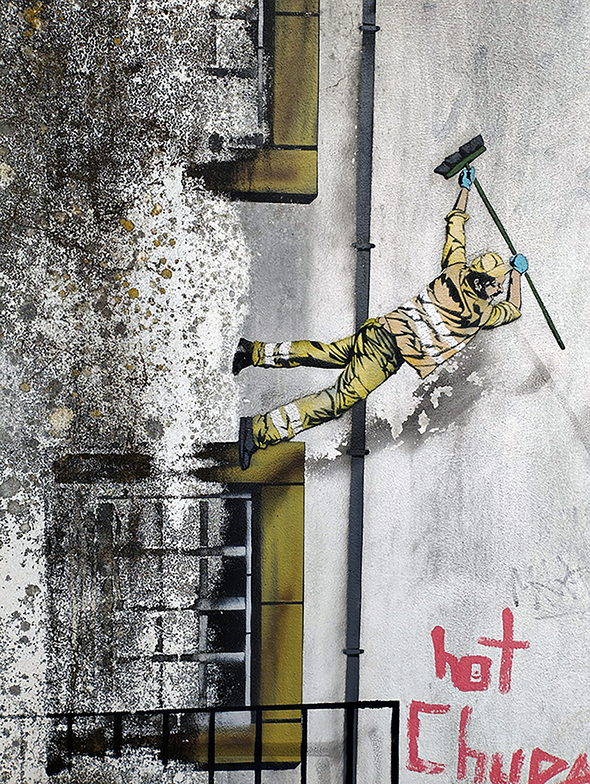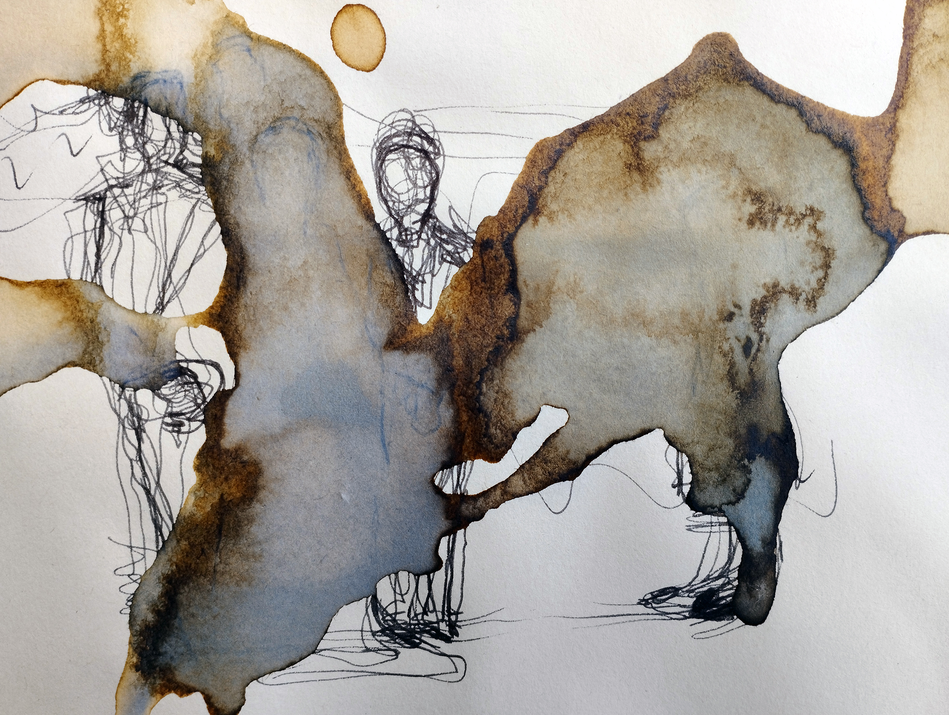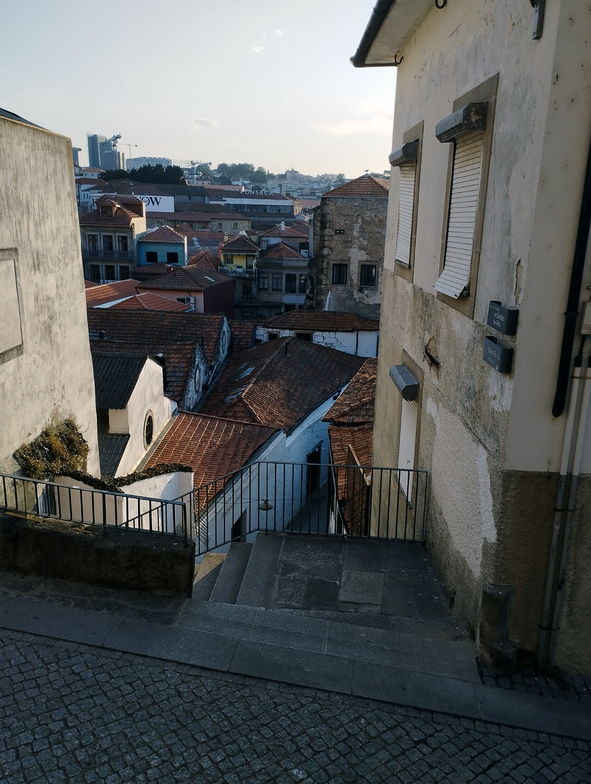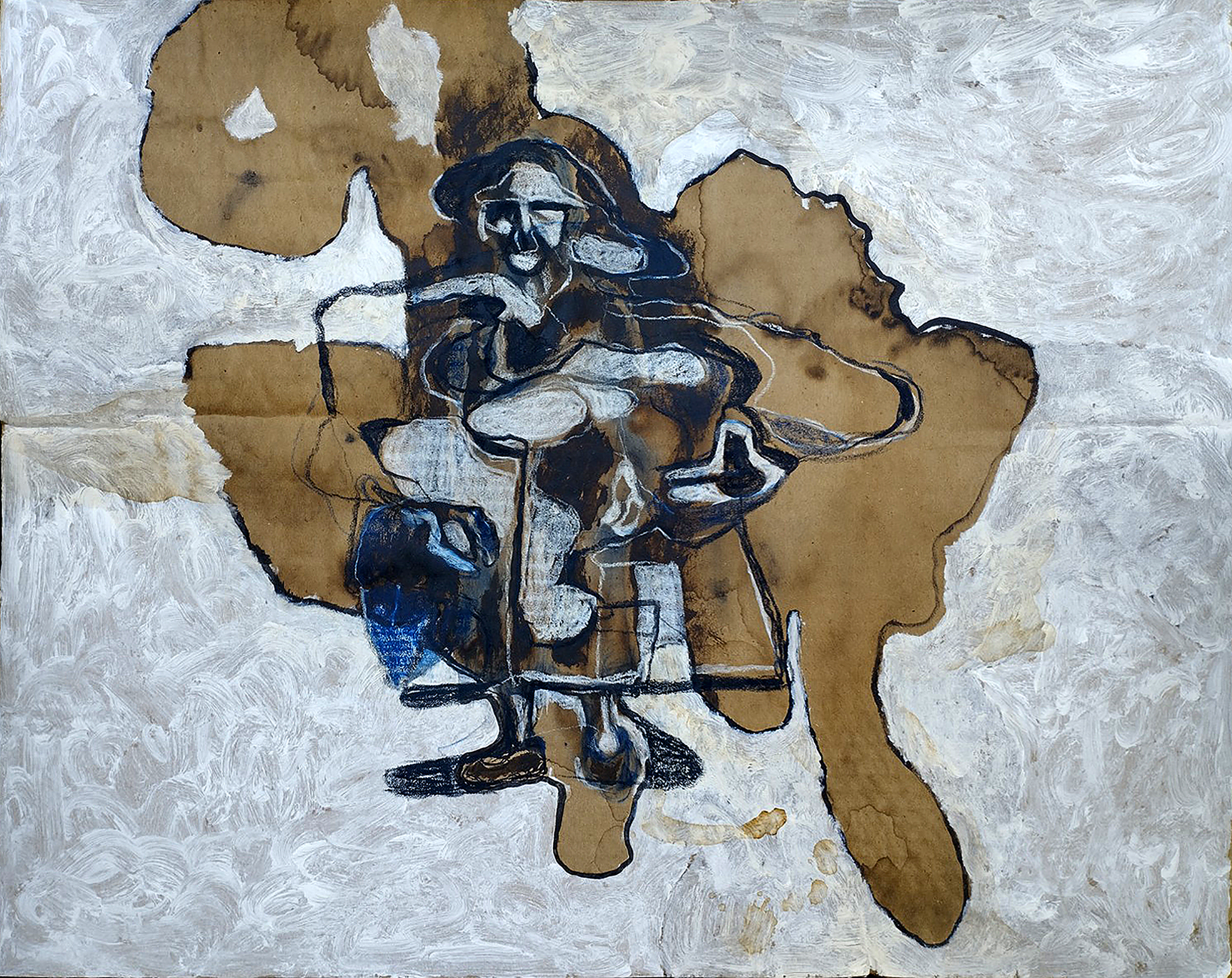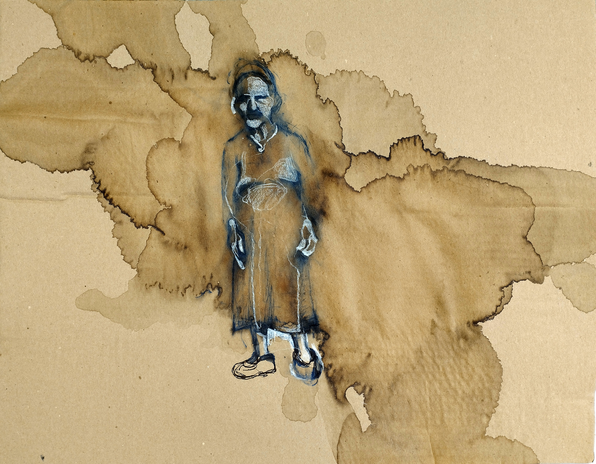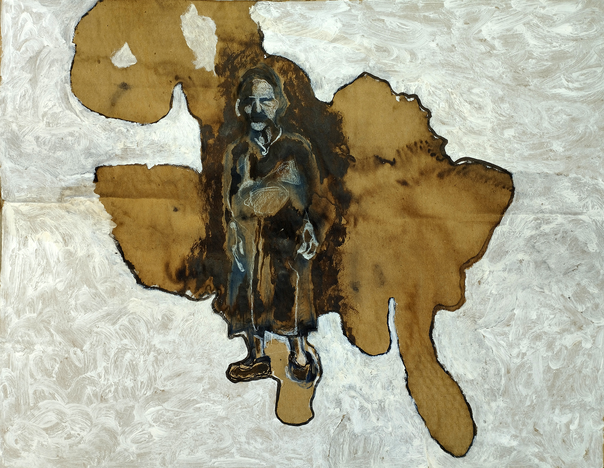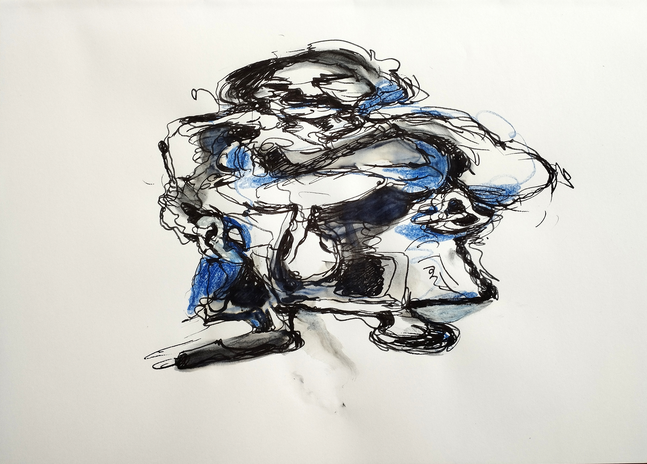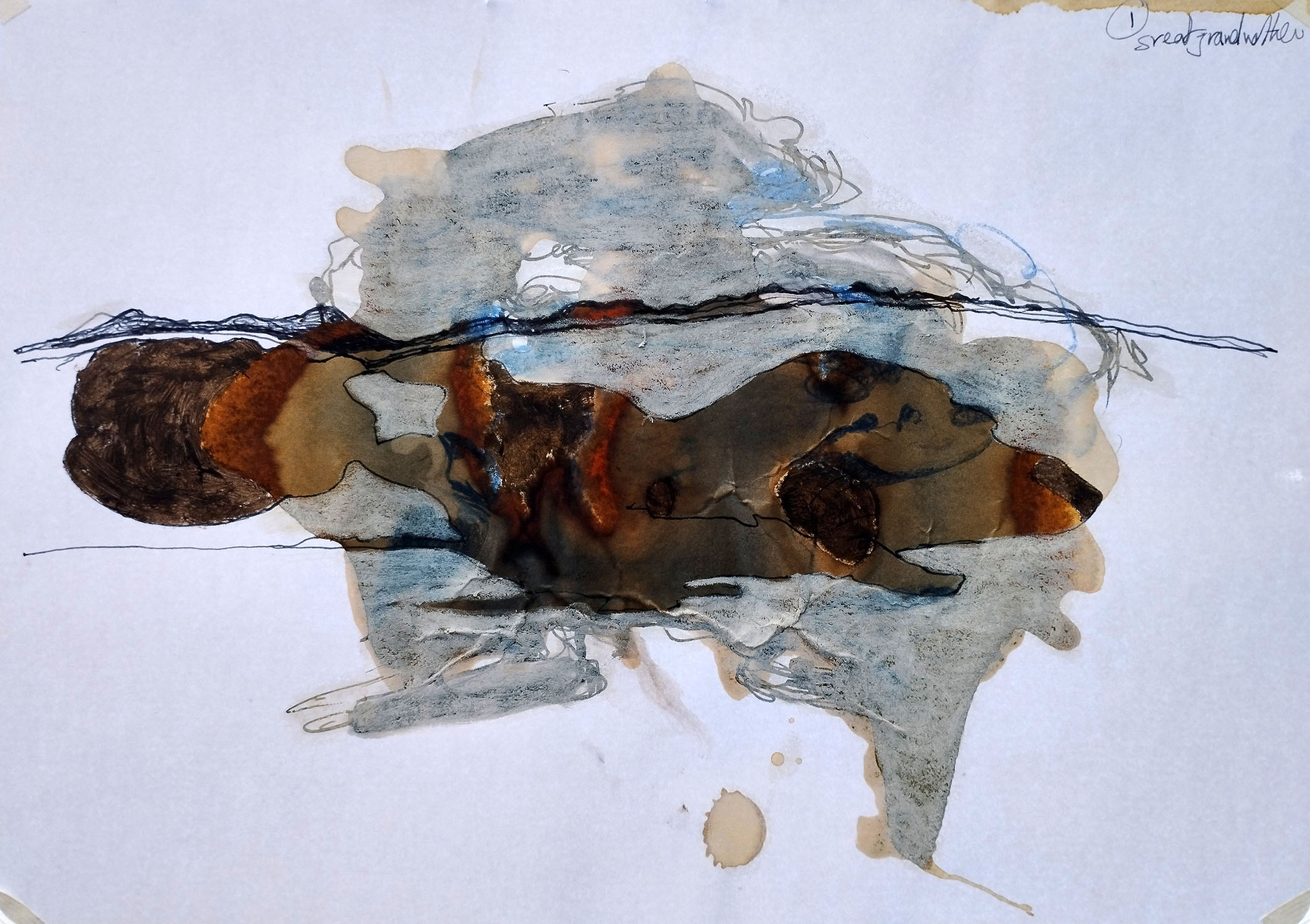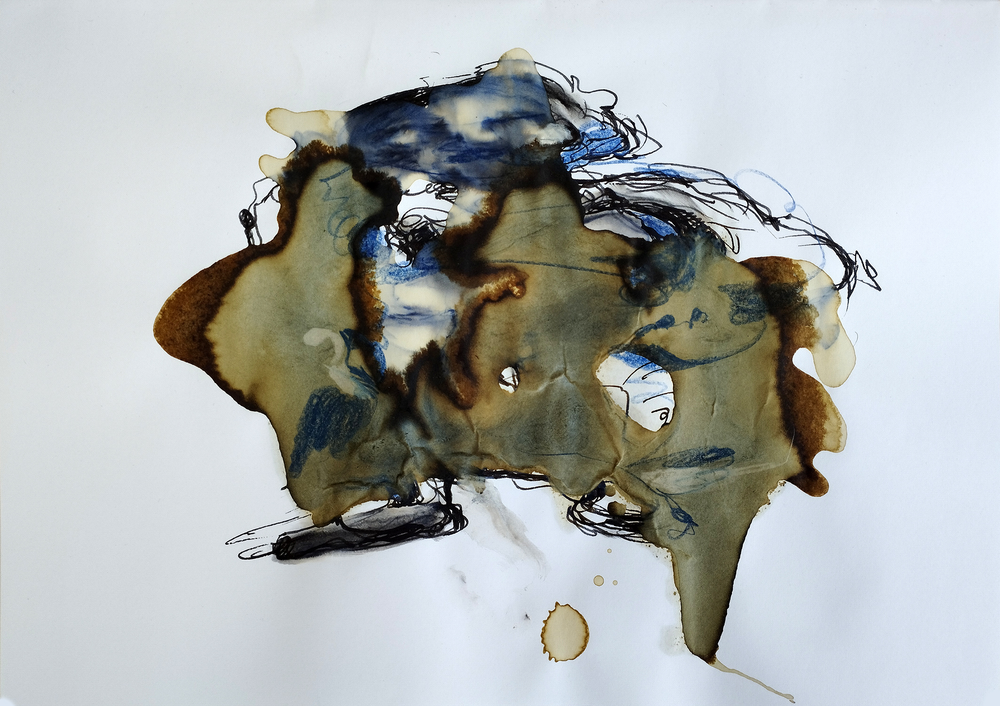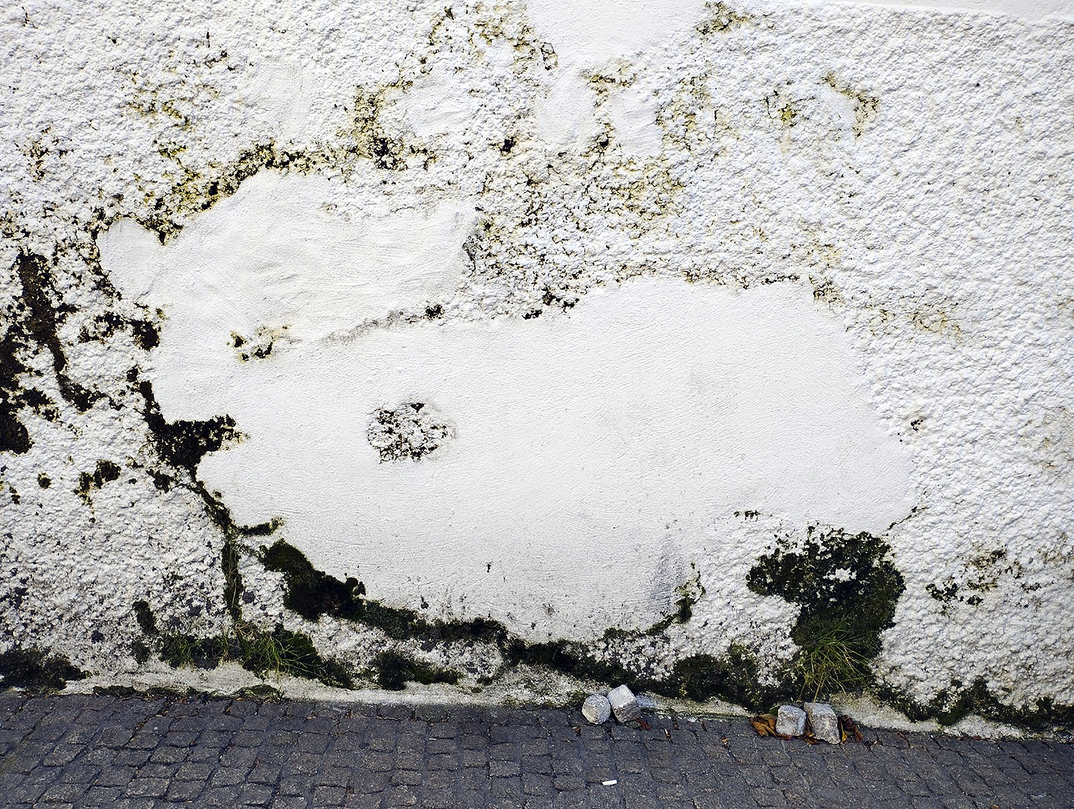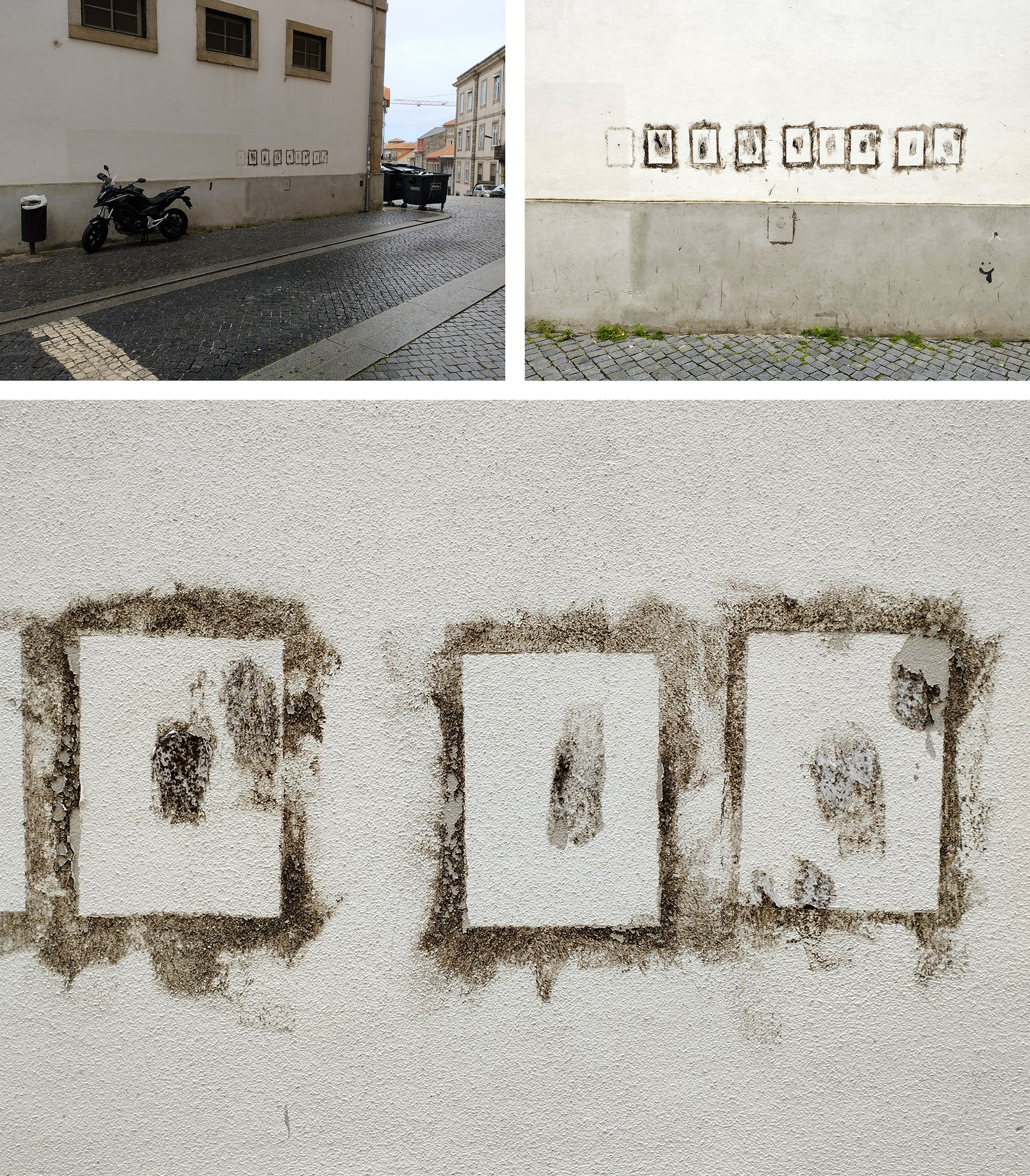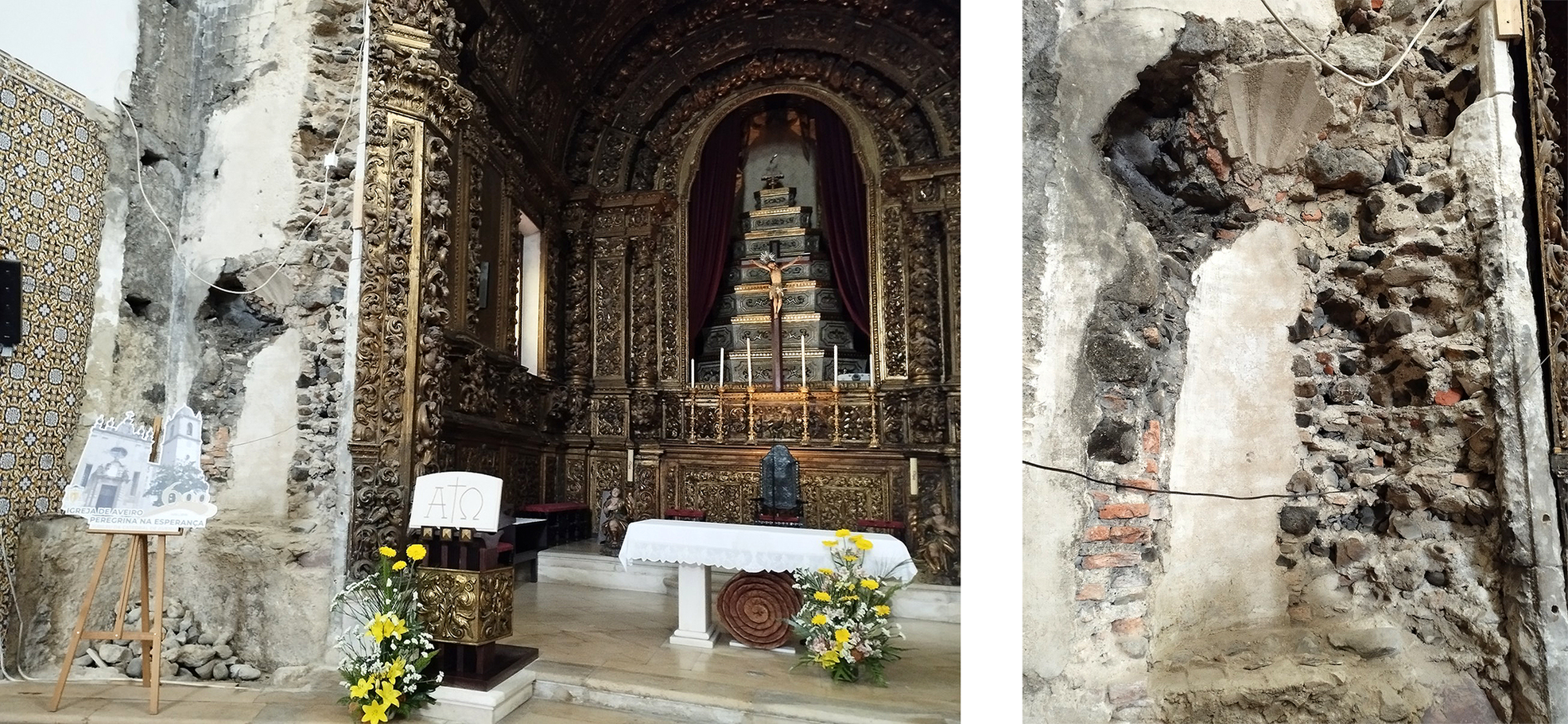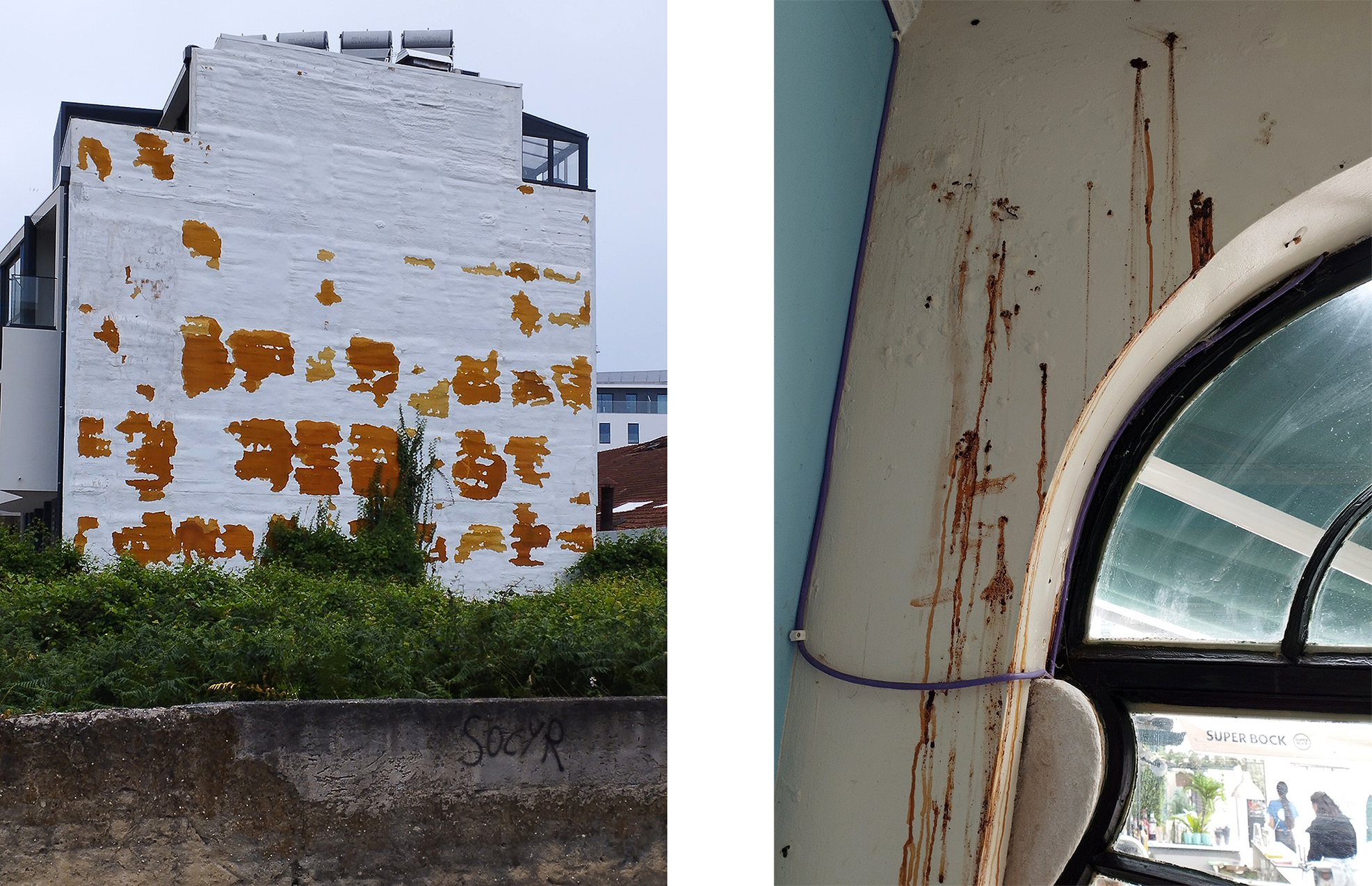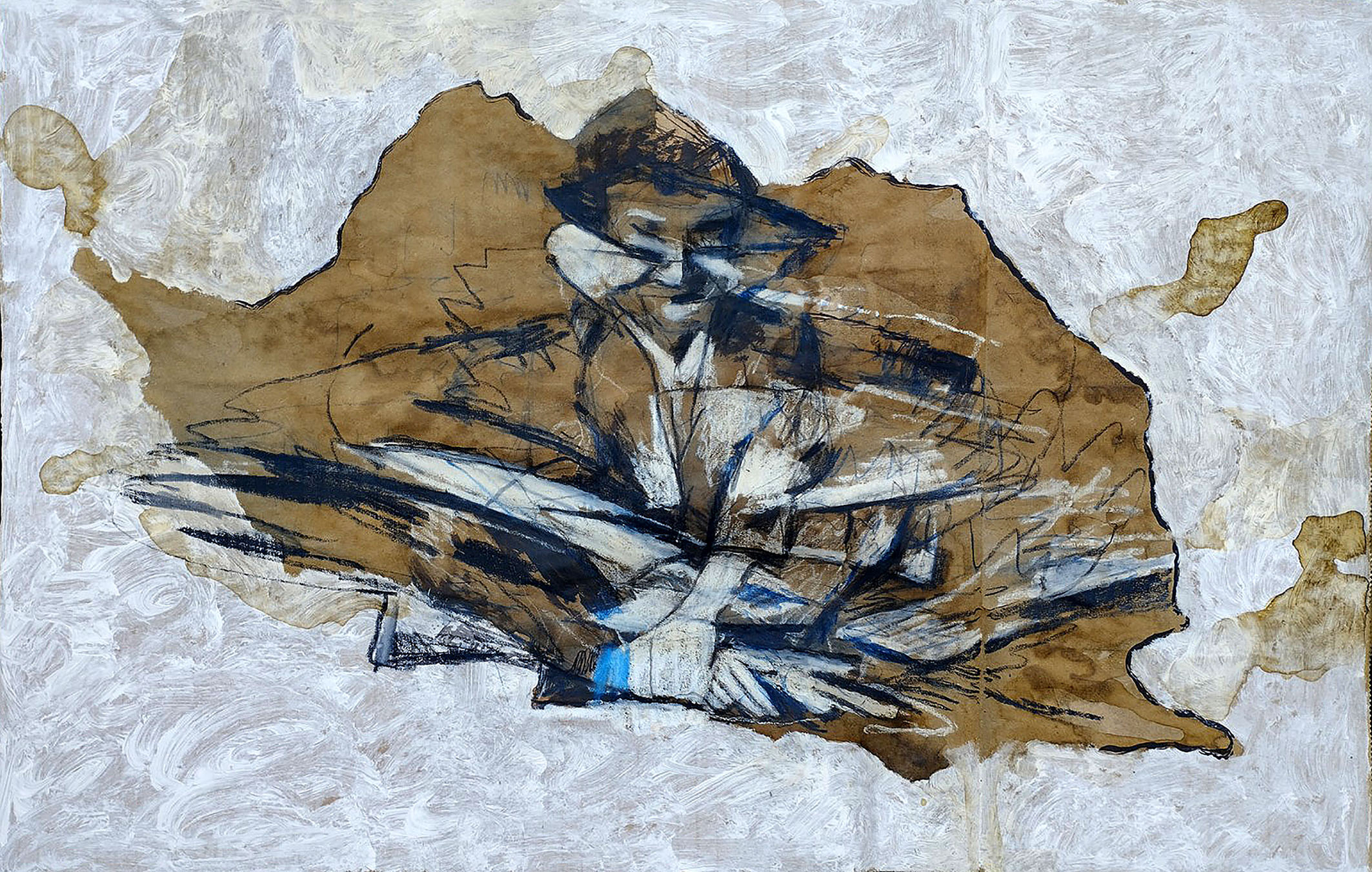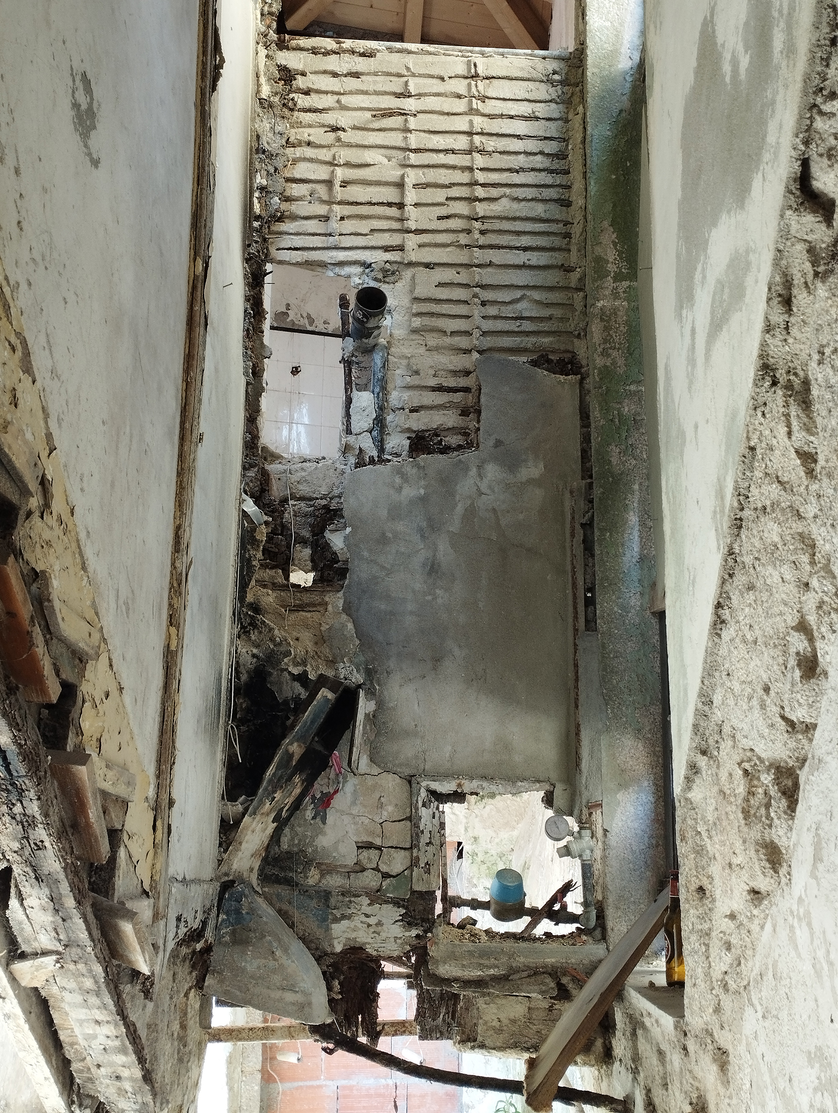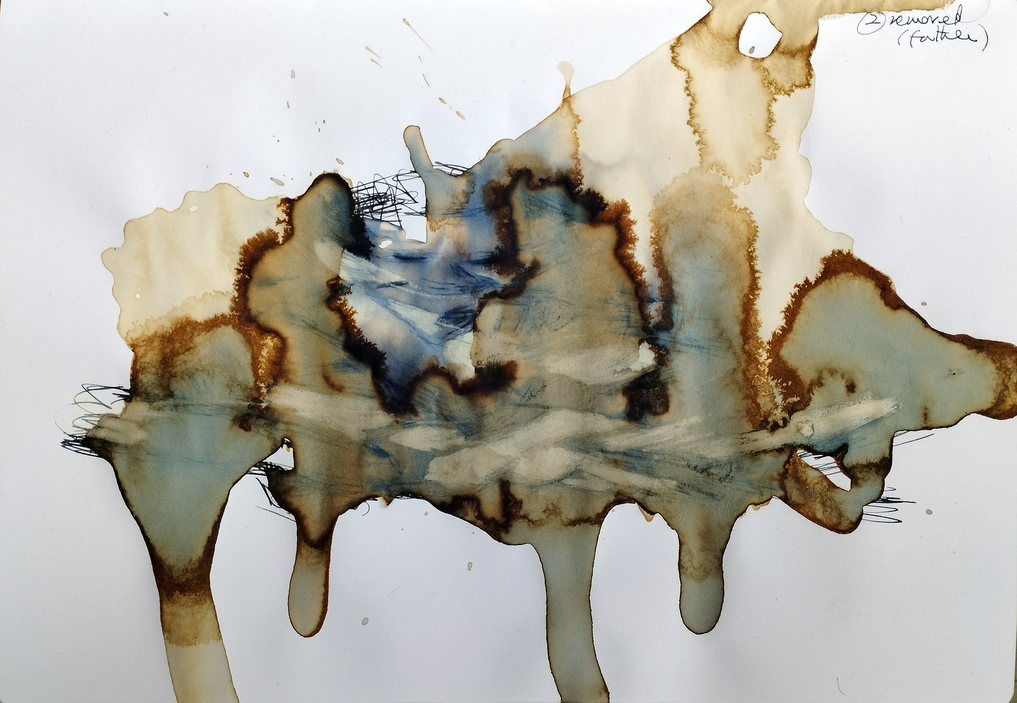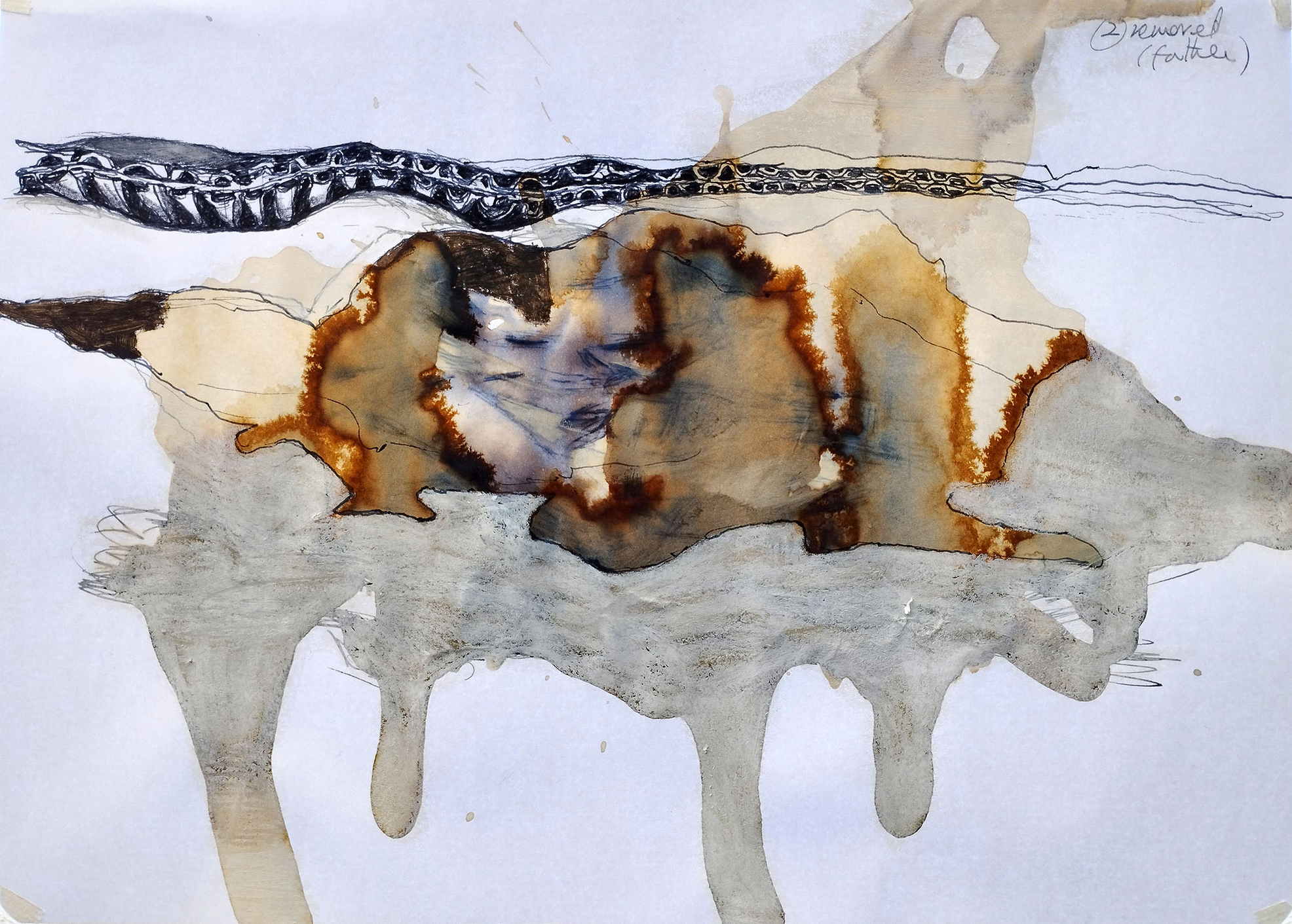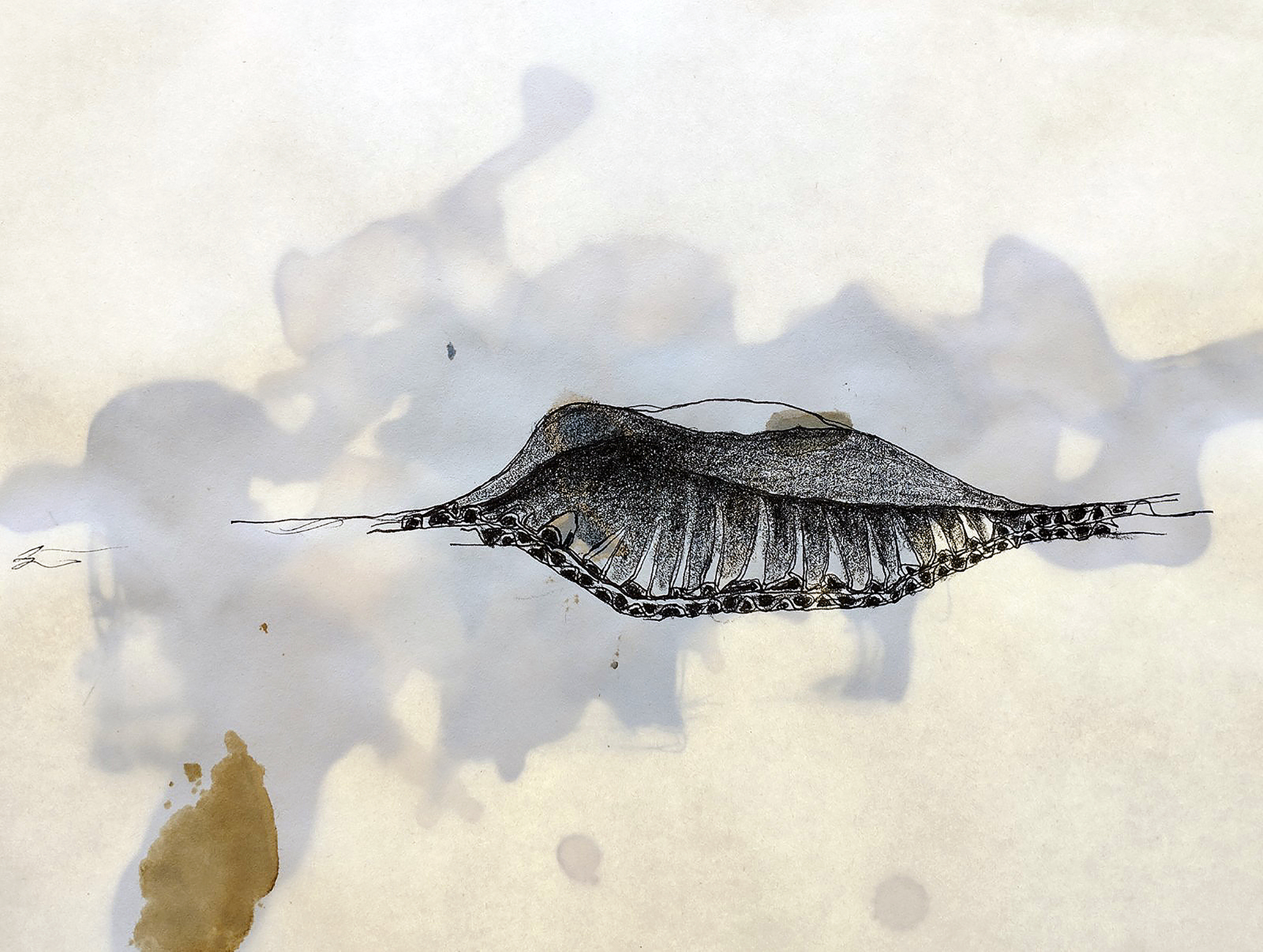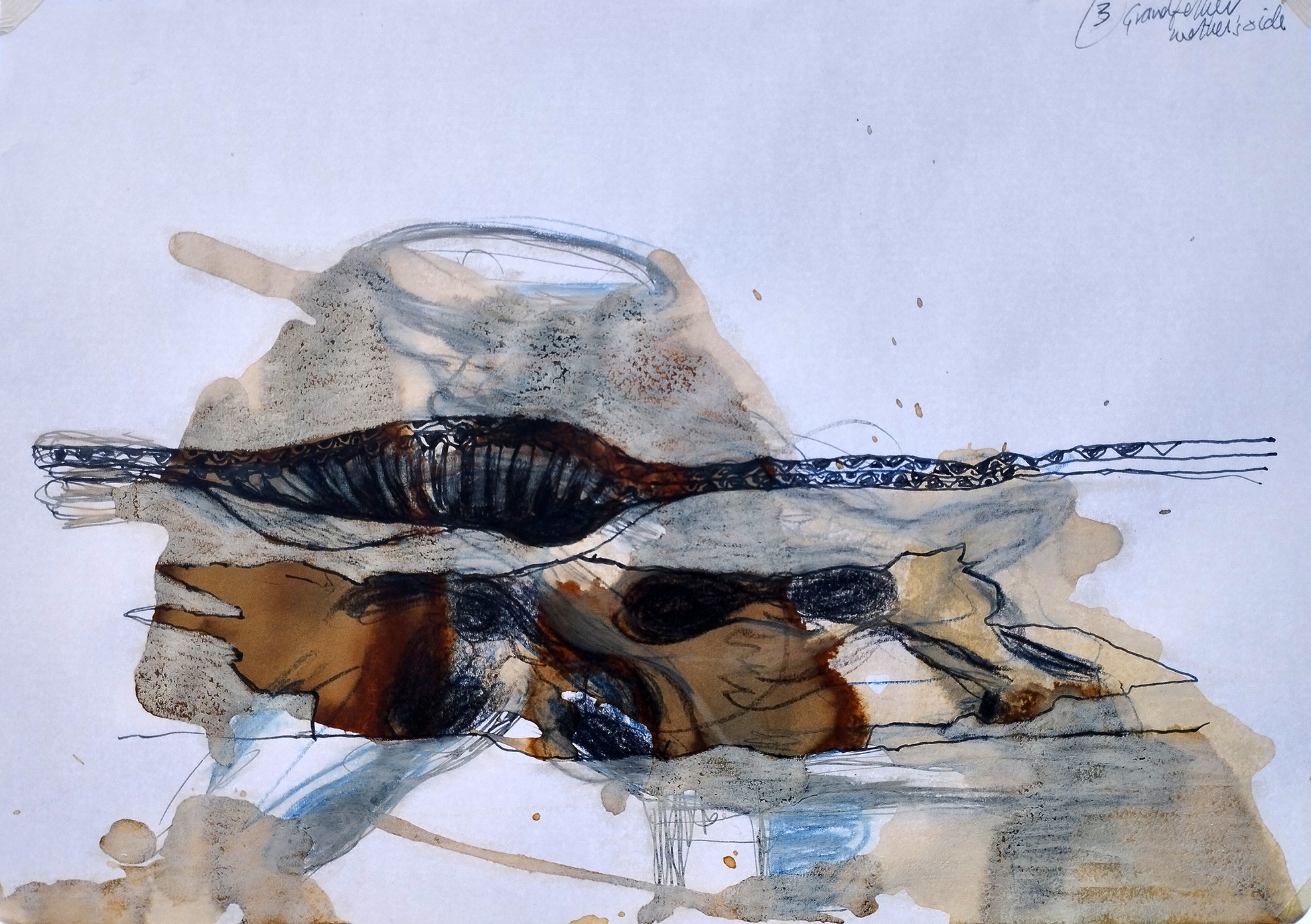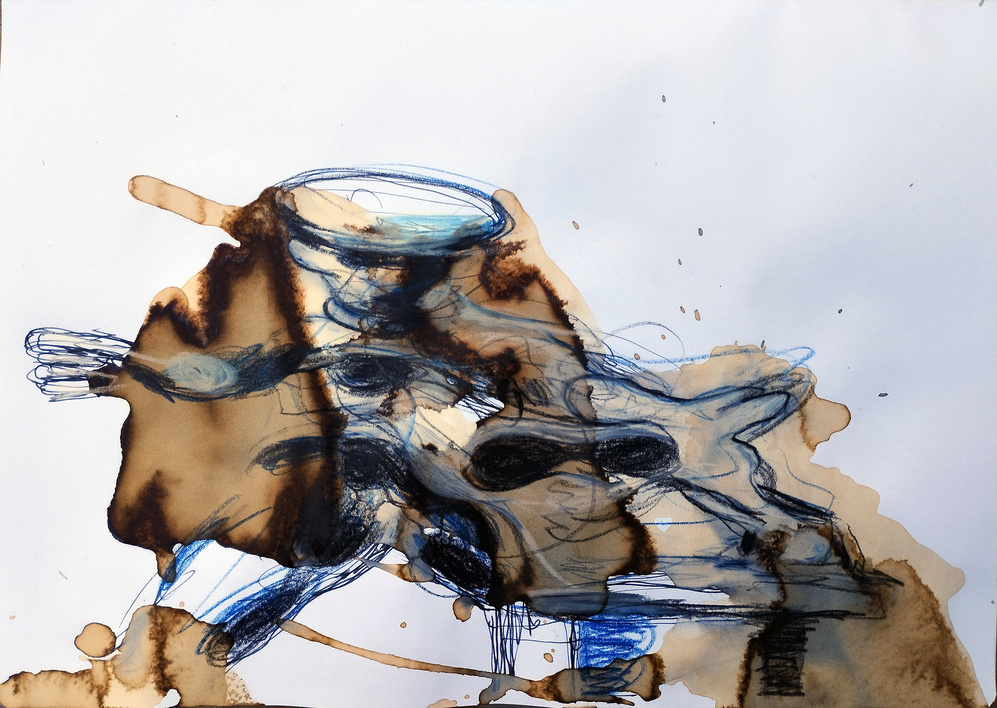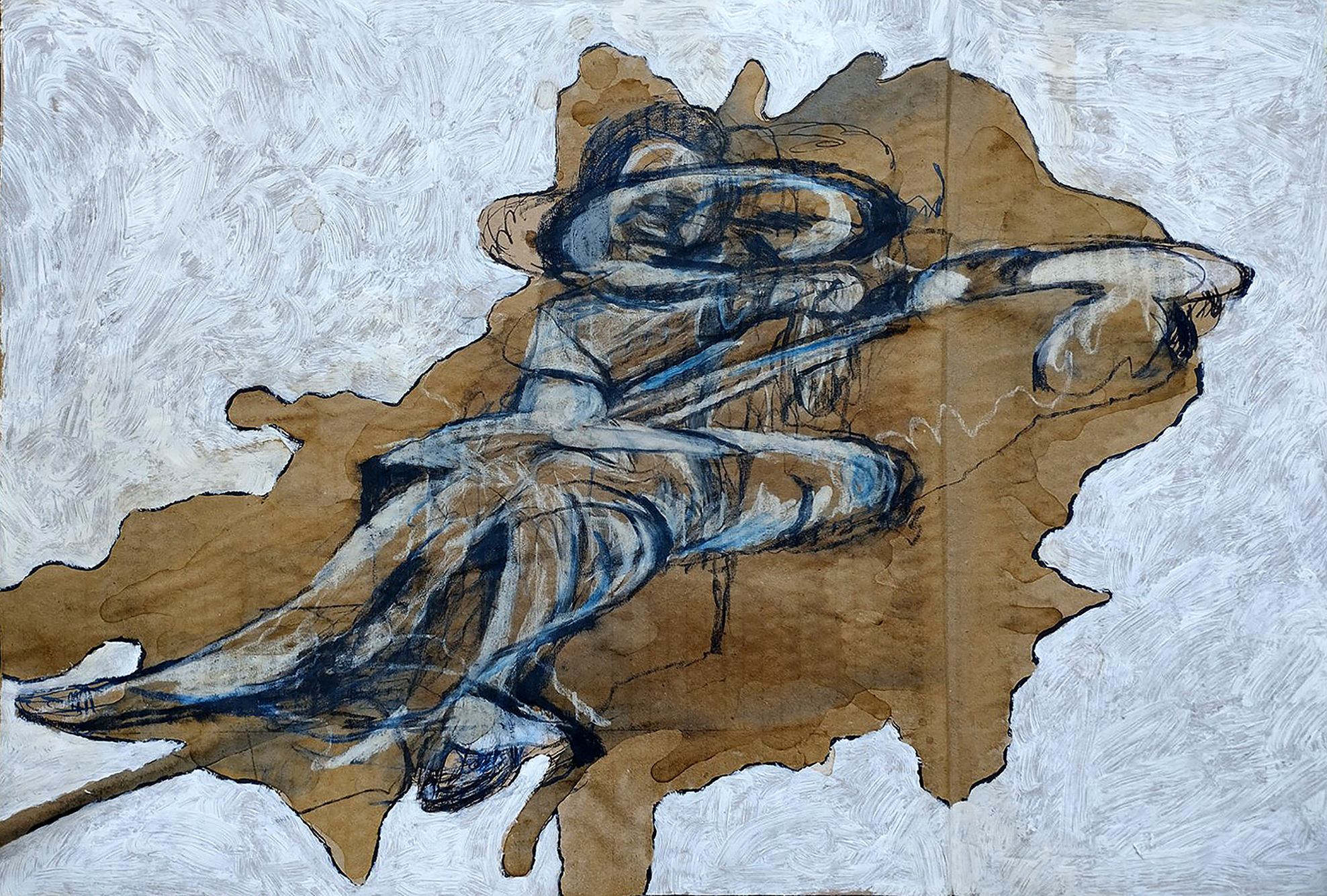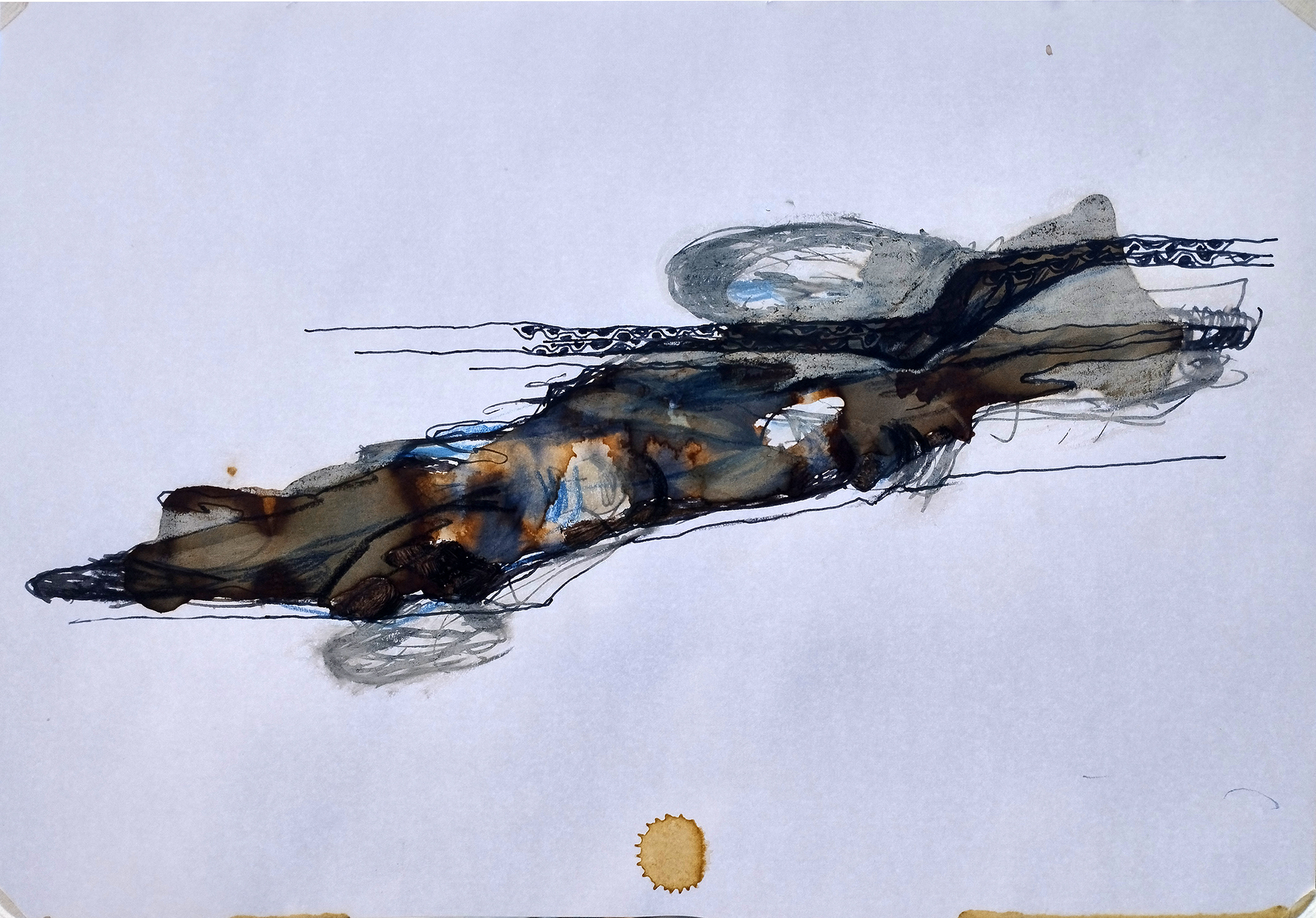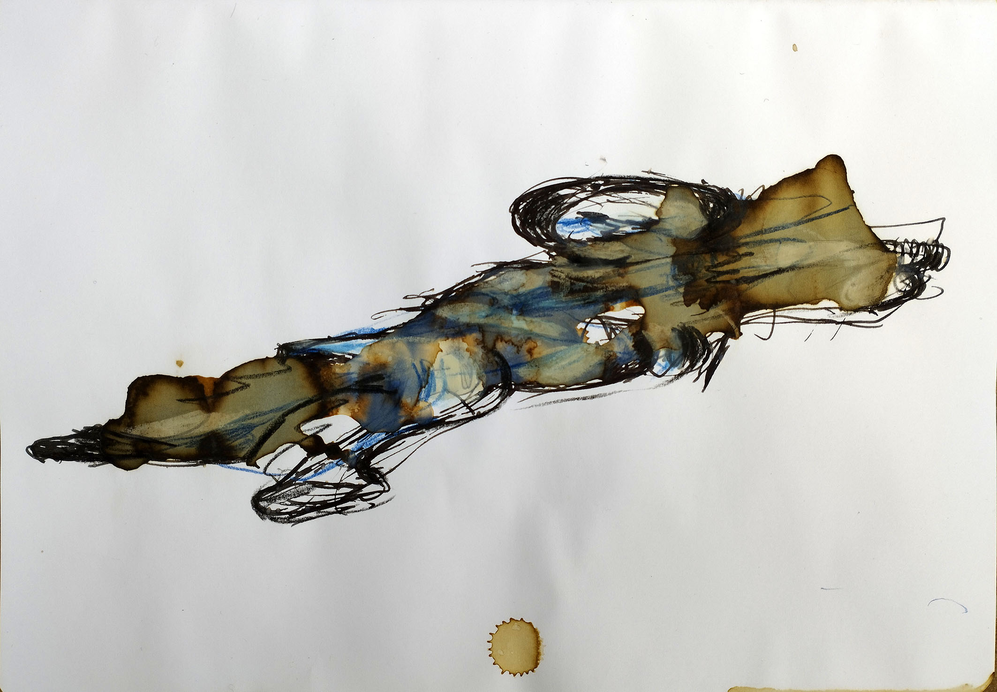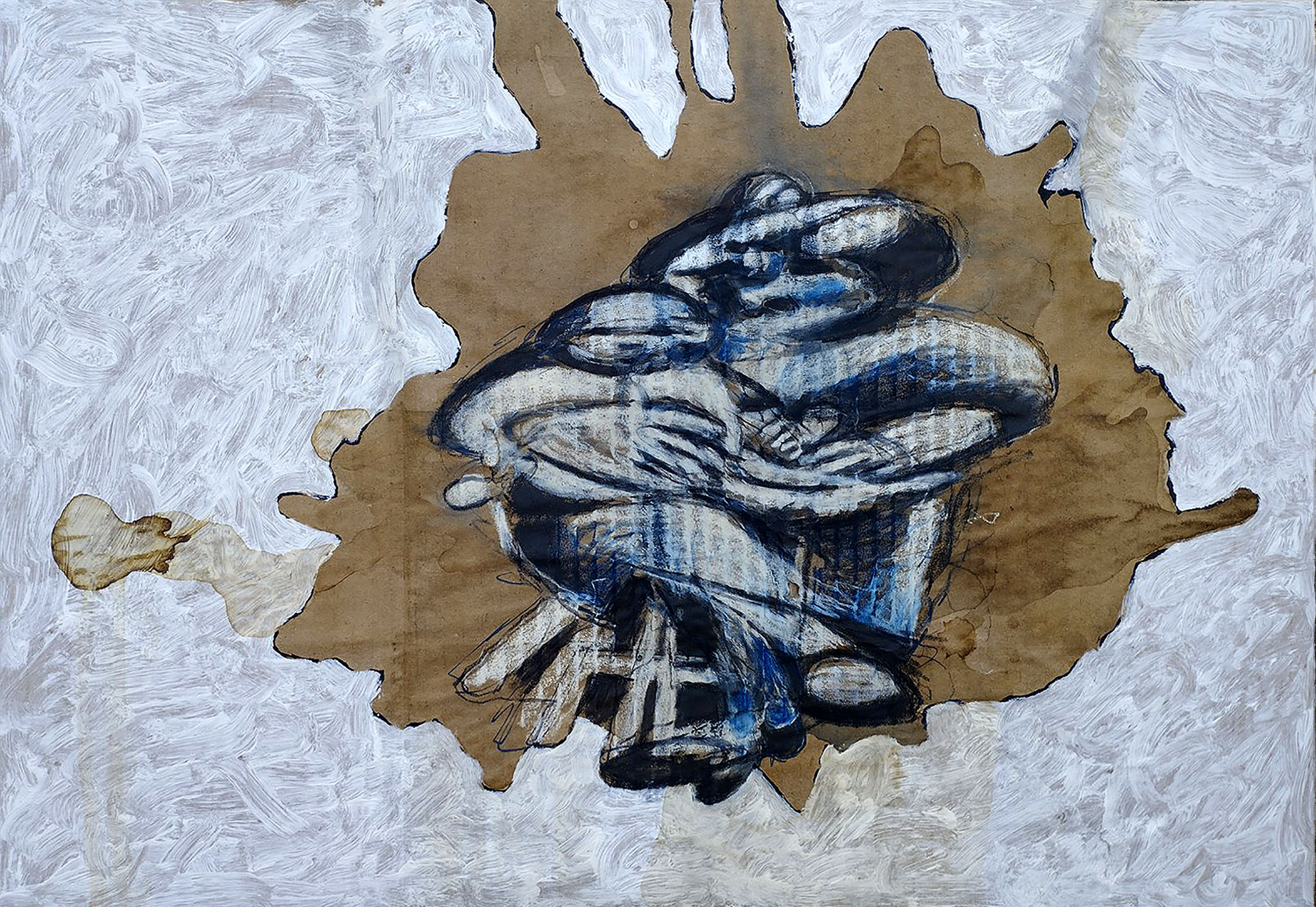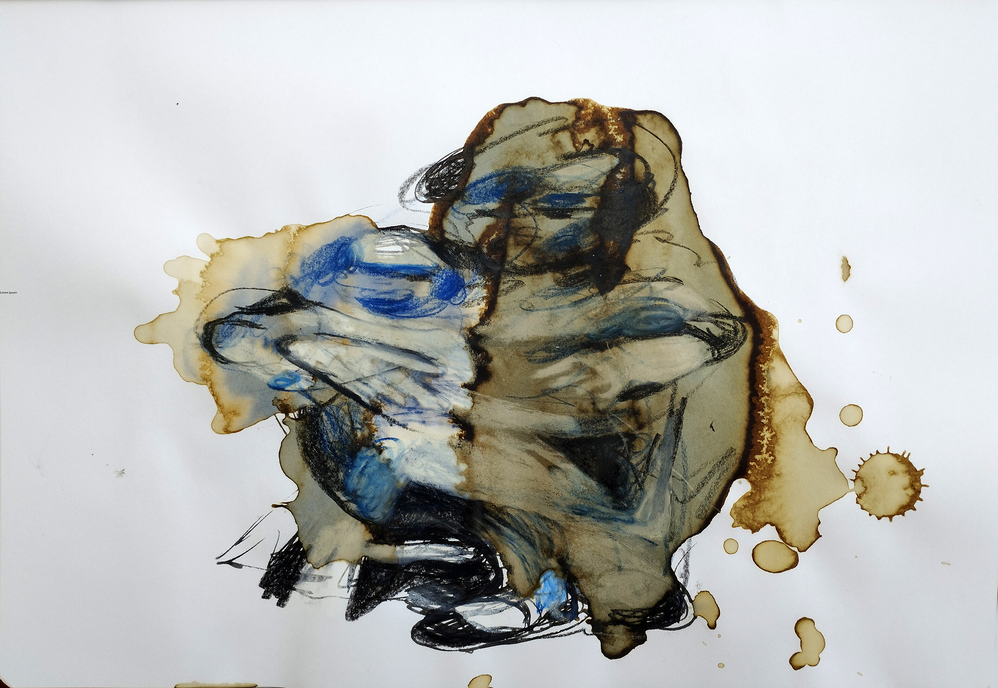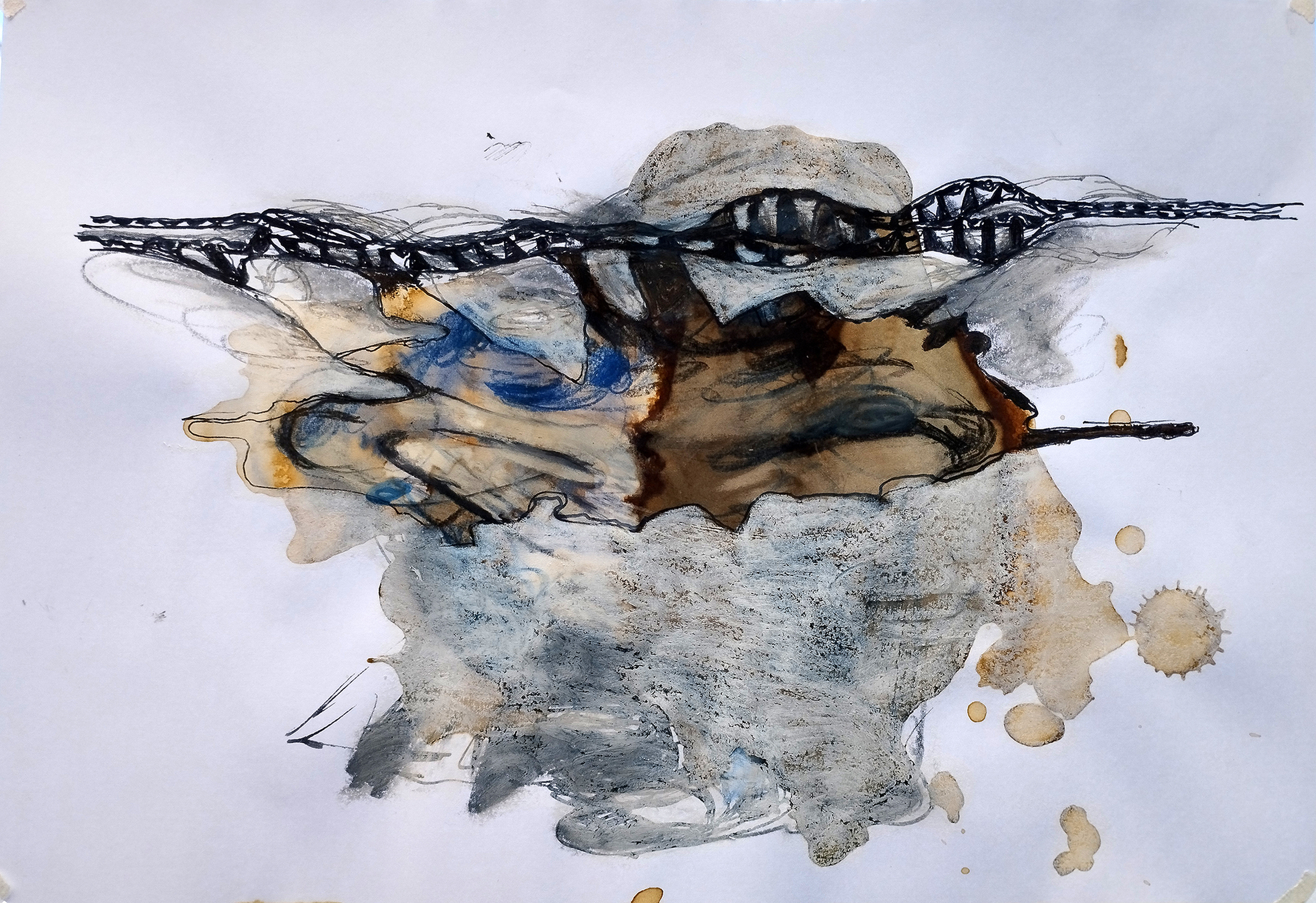Camoens, V de L. (1973) The Lusiads. (English translation 1952, trans. William, C. Atkinson) UK: Penguin
Two contingencies have suggested that this might be a good point to close this Page 1 before aspect of the project. The first has been the writing of a paper in response to a call from a drawing journal, the paper's provisional title of which is 'A Reciprocal Provocation – psychic genes and corporeal fiction – Explored through Drawing'. An adjunctive purpose of writing the paper has been to consolidate my thinking as it has so far developed regarding the ancestry theme, but due to my use of the two sets of drawings of the exposition, these have as much provided the consolidation.
A second contingency has concerned my discovery, through certain reading, of the microbiome. According to Ball (2020, p.139), microbiome is the collective name for 'cells of organisms that exist symbiotically with us, living all over and within our flesh in an arrangement that is mostly of mutual benefit'. These can be, for example, good bacteria in the intestines, and mico-organisms on the skin, in the mouth, and variously around the body. Ball (2020, p.140-1) describes such micro-organisms as a 'collaborative community of non-human cells', which one inherits from one's mother but also from those continually around one during early infancy. Up until reading this I'd considered that the thread, as it were, running through the project would be mitochondria, my progress in understanding this aspect of one's genetic code charted by the analogy I draw to the material ground on which I've been working, namely corrugated cardboard, and specifically its corrugation. While the coffee staining – another key working material – seemed to relate to what I had also discovered regarding fungi, where the latter's tendency to permeate, spread, alter, and create zones, all of this mostly of its own volition in symbiotic interaction with whatever is its ground, is now equally if not more analogous to the function and behaviour of the microbiome.
While the project's theme is obviously scientific, the brief is such that one can respond to the findings of one's DNA ancestry in whatever way feels appropriate through one's creative autonomy. At the present time my response is not only scientifically very tenuous, but comes before even receiving the test results. The artistic research is therefore unfolding in the sense of which it is becoming more- rather than less speculative, for the time-being. Both terms, unfolding and time-being, suggest a between-ness of the period of time of the research process before one feels it necessary to hone in and consolidate. The aforementioned paper, therefore, would present an imprecise narrative if it were not also equipped with a degree of questioning, itself, as part of its research question.
The last visual work at this before stage of the project (see Pages 2 and 3), has concerned the production and mutation of cells that begin with short annotations of the content of this Page 1 formatted to look like cells, what's left of the annotations after their formatting has been subject to coffee staining then isolated as text, and then their further formatting and re-working as mutating cells. As mutational, the artistic process here concerns not so much destroying the presenting combined textual and visual material as developing it through transformation. The emphasis is on cooperation. According to Ball (2020, p.202), '...cells display the kind of responsiveness that looks like foresight, intelligence, collaboration. It is this "looks like" that holds the tension about how we think of identity and autonomy in life'. In the artistic context that has at this time enabled comparison with biology, the identity in question has concerned family near-ancestors that are imagined as in turn imagined by a fictional character initialled M., which distances the images from any possible direct relationship to me. This fictional emphasis is part of the autonomy of the visual-material and textual practice that has used coffee staining and its liquid oscillation with other materials, in some cases also turning them liquid, as both a metaphor for the ancestry narrative and as a key operational medium of the project.
This exposition is my preemptive individual contribution to a research project that will involve several other participants, each responding through the medium of drawing. The opportunity of the project is due to my ongoing participation in a perception project, 'The Observation of Perception, considered through drawing', hosted by i2ADS Research Institute of Art, Design and Society, University of Porto. By chance, due to institutional proximity and indirect affiliation with a larger drawing project conducted through i2ADS that is researching the university-wide use of drawing in pedagogy, I am now also involved in this transdisciplinary research project between fine art and genetics, the latter hosted by i3S, Institute of Investigation & Innovation in Health, University of Porto.
The project title is: 'Call for Drawing – Genetics & Identity', as part of a larger project titled 'Human diversity along the Magalhaes cicumnavigation space: genetics, history and culture'. The objective of this drawing strand of the larger project is '...to characterise human variability across space, in the scope of the Magellan circumnavigational trip, contexualising genetic and phenotypic data with the different social, cultural, and political settings encountered during the first world journey'. The project formally begins after the results of Ancestral DNA tests of each of the participants, which should be delivered and analysed in July 2023, followed by a prospective developmental period of three months through the medium of drawing. At the time of writing, the date is mid-May 2023, hence inferring a prior period of time before the results of the DNA test become available.
This sense of before, as a lead up to informative specific knowledge, is important for my conception of the project; a period of time when I can explore possibilities in a wider sense, construing ancestry unfettered by scientific findings, given that the knowledge available to me of relatives, let alone distant ancestors.
There is and will be an epiphany to the project, however, which concerns the project's medium itself. Of course, this is already inferred by the project organisers' choice of drawing as the general medium of dissemination, but the breadth of scope of drawing is honed, paradoxically, by each respective artist in terms of its nuts and bolts. In Canto Five of the English translation of Luis Vaz de Camoes' The Lusiads ([1952] 1973, p.135-6), Vasco da Gama stopped on his voyage at the 'River of Good Omens' and there: 'We took the opportunity to scrape our keels of all the slime and shells and molluscs they pick up in the deep: after our long time at sea they were badly in need of it'. Analogous to drawing, the length of the sea journey is in a sense what the artist comes in with, as pre-existing experience of their medium, and the scraping off is on the one hand what one sheds of such knowledge, as part of the forward-moving process, to break into new waters, as it were, of artistic research. On the other hand, the traces of the scraping off are themselves the newness, or the cusp between before and after.
Pages 2 and 3 of this beginning stage of the project, referred to as before, meaning prior to receiving the DNA ancestry test results, are two sets of ten details of a larger-format drawing visualised as cells. The cells' annotations, contained within them, waver in their readability and visuality, the typed versions of their annotations conveying their readablity only.
The cells' visuals and their captions indicate oscillation of the project between fictional, visual-material and biological. I mainly form an analogy at this stage of the project between the corrugation of the cardboard, its material and make-up, with the question of blurred boundaries between the organism and the community of cells that make up the organism in the biological sense.
An important point for the project, yet to be explored, is the question of the microbiome – already mentioned above – in its inheritance from the mother but constituted also from influences of those close around one during infancy.
The last question, written into the last cell, reads: "How can the visual-material process embody this?' – meaning knowledge of the microbiome's symbiotic relationship with the genes of its host.
Ball, P. (2020) How to grow a Human: Reprogramming Cells and Redesigning Life (first published 2019) London, UK: Harper Collins
In its wake, the coffee left traces of the representations in ink, of what it had by its own automatic volition lifted from M.'s efforts to roughly sketch human presence. The coffee pulled, distorted, bled and formed individual human presence in terms that could be considered analogous to the mapping of demography. Espresso gave him a slow release of contingent change, returning an anonymous extended family, the boxed set, as M. referred to it, to the closed lid of what had been their indefinite residence in the junk-shop, if not for their morphing into movement of phenomenal consequence. Contours within contours emerged that were layers in and of time. Newly-weds, their parents and grandparents either side of them, variously sacrificed themselves to suggesting their ancestral origin across time and space, albeit whatever imaginative reading can be superposed on what is in itself quite impoverished material, Figure 2b.
M.'s final re-working of the sketch determined five likely descendants; a male and female couple in their wedding photo, what could be a grandmother, a father of the bride, and an aunty, perhaps to the bride's father and therefore daughter of the grandmother. Inasmuch as the married couple could substitute for M.'s parents, the grandmother character would of course be a great-gandmother to him, and the aunty a great-aunt. M. has pointed up in crayon the characters that most remained after the coffee applications, Figure 3.
Fig 4/5/6: Two fresco details and a locational shot taken in Vila Nova de Gaia, south side of the Duoro River, Porto, variable dimensions © Michael Croft 2023
The city of Aveiro in central Portugal has on one of its walls a tile-painted fresco of life of the city's fishermen, such figures and their activities abstracted into simple bold shapes. What causes this to be of interest to the present project, however, is its sense of decay, presumably due to its exposure to the elements over time, Figure 7.
M. knew nothing of his biological family, and initially neither did he think that he cared, since he had been orphaned at birth. During a year or so chancing the luck that was prevalent and in the habit of going strongly either way due to the kind of person that he was, M. developed an interest in coffee, at first serving it in his capacity as waiter in restaurants and then through owning his own cafe and gradually expanding the business. During one of his early life's many adventures, he encountered a wealthy person who became his benefactor, to the extent of providing him with a means to start on a modest career path that utilised whatever practical skills he'd picked up on his travels.
Once, when rummaging through the junk-shop of a friend he'd made in the city, near the market on which his then-employer relied for fresh produce, M. chanced upon a plain brown cardboard box, about the size of a tailored shirt-box, of black & white family photos. He had, at that moment, something of an epiphany. These, he proclaimed to the bemused and very elderly shop's owner, would be his family. Among the evidence of lives that had mostly begun around the 1950s' would be a narrative that he could piece together that gave him a semblance of love and protection that had been hardly provided during his childhood. Perhaps more importantly than this, however, M. could indulge his predilection towards telling stories.
The junk-shop owner shrugged and gestured dismissal towards the box of photos after M. had expressed such interest. His shop's space was plenum, its contents held in place by wrought-iron bedsteads, his ankle-length greatcoat bound to his decrepit body with a curtain sash. Curiously, however, the nearest he found to a fit in his adopted family were among the oldest of the women, which is also saying something of the empathy he had with his present elderly friend, albeit of male gender, who would spend inclement days pacing a narrow space provided between the metal shutters of his shop and the mountain of domestic degradation that he nurtured rather than sold. While he had regard for this old man, M. resolved to strive as best he could not to become him. A question surounded this as a conscious choice, however: how might one actually see such a thing? How could a feeling about something that was after all triggered by and as a visual impression and influence, be visualised?
We're talking pre-computers, and therefore pre-internet. In M.'s day as a spirit permitted the freedom of a day a week, alternately a Sunday or a weekday on a rolling basis, shared with his co-workers, he wandered the city enough to discover a public library, and browsed the shelves for basic information about coffee. Thought to have its origins in East Africa, in what is now Ethiopia, coffee, M. discovered, was introduced further East as a product of the sea trade that had developed in the 15th century, and by the 16th/17th centuries was securely established as a beverage throughout Europe.
Demographics, M. read, the movement and development of human populations, in conjunction with commerical trading, were as likely to have resulted in the world distribution of this product. It amused him to consider that his ancestral origins may have been on a plantation, while cautioning himself on the fact that amusement in one context could be unethical and immoral degradation in another. But he wouldn't go there; his was an interest burgeoning from a box of anonymous grainy photos that had even, from time to time, become corrupted by the stains of his own coffee bubbling untoward from his espresso machine that he moved too quickly from the gas flame to a small kitchen table that was strewn with the visual signs of his adopted family.
While the 15th century was not, of course, 200,000 years ago, M. found it of intense interest that the movement of early human population was from East Africa, its seat of origin, to S.E.Asia and the Middle East by 50,000-, and to Europe by 20,000 years ago. Coffee, albeit many centuries later, followed approximately the same trail, Figure 1.
Fig 1: Hand-drawn map of movement of early humans from their earliest evidence in East Africa © Michael Croft 2023
The degradation of the photographs by coffee had triggered M.'s creative imagination, and while he was loathe to destroy his precious evidence of his surrogate family, he realised that by accepting his own extreme limitations towards sketched versimilitude he could explore the coffee metaphor as a medium of erasing precise human circumstances in order to spread, literally, the dissemination of human movement in global terms. Coffee, as it impregnated the page, both mapped its own movement and resembled the earth's terrain, Figure 2a, below.
Fig 2a/b: Sketch of family members degraded by spilled coffee. Ink, coffee on paper, 29.5cm x 21cm + detail of variable dimension, attributed to M., 2023
Fig 3: Sketch of family members, Figure 2a, reworked with white and black crayon. Ink, coffee, crayon on paper, 29.5cm x 21cm, attributed to M., 2023
The possible great-aunt image had seemed surplus to the idea as the family group (see Postscript, Page 3), respectively father and mother's side, that has evolved through the drawing process. In retrospect, however, which is to update through present thinking and knowledge this earlier resolve, this figure, along with the anomalous landlady – up ahead – and at least one other more distant blood relationship, could now key in with a later question of the project concerning the microbiome.
Fig 7: Fishermen and their wives fresco, entire mage and details, Aveiro, Portugal, variable dimensions © Michael Croft 2023
Where the decay is most noticeably shown in Figure 7, above, is in the imagery of the seated and standing women, top-right corner of the photographed set. Primarily, the colour has broken away at the edges of the tiling of the blue garment, and has worn away on the cloth in the lap of the seated figure. However, in all aspects of the fresco there is a sense of degradation of colour and its materiality. Arguably, however, the effect of the elements on the colour and material, and their response, is symbiotic, and the resulting reduction of pristine clarity of colour and modelling has given way to an investment in the imagery of the very elments with which the fishermen are battling.
A commemorative statue to the 'Carquejeiras', or Gorse women of Porto, can be found in the Fontainhas area of Porto, at the top of a steep incline from the River Duoro. These were women in the late 19th/early 20th centuries whose job it was to drag gorse, which was a plant that had several economically advantageous properties, up from the embankment in sacks on their backs, Figure 8.
Fig 8: Plaque and sculptural monument to the 'Carquejeiras' (Gorse women) of Porto, variable dimensions © Michael Croft 2023
The sculptural formalisation of the Gorse woman shown in Figure 8, top-right, is comparable to the figures of the Aveiro fresco, Figure 7. However, what is useful to the present project is the representation of the gorse variously poking through the sack, and how this may be considered grouped into cellular clusters in turn linked by the delineation of the stretched bulk of the sacking. The formalisation of the figure and that of the sacking are in accord, and may be considered symbiotic.
The idea of fictionalisation of the project is to ambiguate the referenced near-ancestry. While I do resource some aspects of my past, the latter is obfuscated sufficiently through the project's mediums to leave my connection with the fictional protagonist subject to question. I wonder, however, if this isn't also what happens inevitably when working in the visual-material medium; that without a signature given to one's work, it has and operates through a degree of autonomy. Of course, a medium's autonomy can never be complete, as it, and its relation to any other, is always being operated upon at the quantum level either physically or biologically, unless other influences are more apparently in operation. This strategy of fiction as part of the project is to suggest an issue at the heart of artistic practice, the ambiguous nature of which is better articulated at the level of such a practice as research. The character I will from here on refer to merely as M., has been with me for some years as an imagined third-person of my creative endeavour.
M. may not have travelled to Porto, Portugal, although some comparision can perhaps be made between particular Portuguese and a more generic idea of European architecture. The more likely, therefore, that M. would also have noticed some coincidence between the imagery of the photographs, below, and his first efforts with stained sketches, Figures 4 - 6.
The two photos taken in Vila Nova de Gaia, south side of the Duro River that divides Gaia from Porto, Figures 4 and 5 (left and centre), are painted frescoes on a wall below the steps shown in the photo Figure 6 (right side). Figure 6 is also an example of the kind of urban architecture that the fresoes strive to represent. What's primarily interesting, however, about the fresco details, is how the realistically portrayed human figure in the centre photo – of which there were several other instances – is both emerging from the decay of the fresco and is clearly also separate. Even more exemplary of this tendency is that of the door, windows and balconies. Heightened by the presence of newer applied graffiti, one is inclined to interpret the figures as wall cleaners, and the subsequent corrosion of the actual fresco as an indication of what would as likely happen if actual cleaners were now tasked with its removal. History remains, but oscillating ambiguously between its evidence's removal and recovery.
While this part of the exposition is declared fiction, the latter's genre combines elments of autofiction and hybrid fiction. Part of its hybridity involves the adaptation of existing knowledge of my own, as the project's author, and otherwise to the building of a portrait of an imagined life from the perspective of ancestry. As such, the sketch diagram, Figure 1, is taken from a source that reflects knowledge that may not have existed, or have been so definitely stated at the time of which M. was frequenting the public libraries of his city.
M.'s initial rummaging in the junk-shop had now caused him to sift through a sizeable batch of family photos, cataloguing the human evidence of each of the families of the newly-weds according to likeness, repetition, and creative imagination. From what he could tell, and construe, the male side stretched back as far as a great-grandmother, the maternal line of the paternal side of what would eventually be his mother and father. (This was hardly ancestral, but it would have to suffice.) This old lady would, to reiterate, be a rocky promontory, analogous to that of the Cape of Storms (now Cape of Good Hope), as described in Camoens' The Lusiads (1973, p.128-31), where the giant 'Adamastor' first introduces himself as 'a cloud... a monstrous fearsome thing' that gradually became 'of fantastic form and size and powerful build', and explains how he was finally transformed into 'hard earth', his 'bones to crags', as the most southern tip of Africa. While the gender is obviously different, M. needed this idea of the laying down of his chosen great-grandmother, though morphed into the earth as represented by the stains of coffee. Whether monstrous or benign is irrelevent; what would be more important would be the effect of the coffee on the form, and the association of coffee with terrain, Figure 9.
Fig 9: Great-grandmother image. Ink, crayon, coffee, white acrylic primer on corrugated cardboard, 49.5 x 40cm, attributed to M.
Again, from a vantage-point outside the fictional narrative, one might consider how the above image, Figure 9, was constructed. Each piece, the visuals no less than the text, is part of a jigsaw, the latter of which, as a metaphor, is not unsuited to my working method. The actual material has a degree of slightness commensurate with the fact that any visualisation within such an exposition exists only in the virtual domain, Figure 10/11/12.
According to the New Scientist (2022, p.47-8), there is evidence that humans were in Africa by two millions years ago, and were using tools, and by 1.9 million years were migrating to Java and Indonesia. These two regions, Africa and S.E.Asia, were pivotal to M.'s idea of imaginary origin of his ancestry that would eventual settle in Europe.
Camoens, V de L. (1973) The Lusiads. (English translation 1952, trans. William, C. Atkinson) UK: Penguin
New Scientist (2022) Human Origins: 7 million years and counting (First published 2018) London; Boston MA: John Murray
M.'s adopted great-grandmother held her own as his invented image, a figure of gigantic size dominating her geographical region; stretched across a land as a sole symbol of a race of humans that had occupied it for at least 20,000 years. Coffee had been the old lady's own vocation, in her day. Her ancestors, unbeknown to her, had traveled with the beverage, the source of which had also been the original location of the human genome. The same liquid had now spilled her, as it were, into the present.
Fig 10/11/12: Two early states of Figure 9, above, and a sketch of the same image, Figure 12. Ink and crayon on paper, 29.5 x 21cm, attributed to M.
The Great-grandmother image, mother's line, Figure 9, has been observed from its top narrow dimension, which reveals the cardboard's corrugation, and has been drawn onto the sketch image Figure 13, above, in oblique view. The image has then been modified according to the new drawing and photographed against natural light, Figure 14.
Fig 14: Great-grandmother image, Figure 9, observed from the top narrow dimension of its corrugated cardboard support and drawn onto the sketch image, Figure 13, the latter image re-worked. Ink, crayon on paper and acrylic paint on paper, 29.5 x 21cm, attributed to M.
Mitochondria, the genes of which are always derived from the female (mtDNA), are apparently associated with the production of energy within the cells of the body, caffeine having been shown to improve mitochondrial function (2012). This scientific link between mitochondria and coffee is essential endorsement of the use of coffee and its staining as a metaphor for the continued presence of mtDNA in the human body, and its genetic stability throughout blood-linked generations of the individual human.
Fig 13: Great-grandmother sketch degraded with coffee stain. Ink and crayon on paper, 29.5 x 21cm, attributed to M.
M.'s adopted great-grandmother exhibiting, through the very morphing of her composition into and as liguid coffee, the latter of which is here used as a metaphor for the energising productivity of mitochondria, Figure 13.
This is an important point:
The help that caffeine provides mitochondrial function in the human body is close enough on the biological level to be able to use coffee staining as the project's operative associational medium to scientific matters that are at this stage relatively unknown to me, as the project's author.
Figs 16/17: Photos of a wall subject to mould, and a view down through the ramins of a house during renovation, Porto, dimensions variable © Michael Croft
The Serralves Villa, an Art Deco villa from the 1930s in Porto's Serralves Museum of contemporary art, has within it doors and cabinets where mirror glass has corroded in ways that suggest organic fungal growth. While the corrosion in the example, below left, echoes in its own terms the marble veins of the floor both outside and reflected in the mirror, the example, below right, sees considerable corrosion of mirror glass on three sides and bases of a glass-fronted cabinet bouncing off one another, Figures 18/19.
Figs 18/19: Photos inside the villa of the Serralves Museum, Porto, dimesnions variable © Michael Croft
What is also interesting about the church interior in this condition, Figure 23, is how much the exposed composition of the stone structure is echoed in the Baroque floral decoration, especially noticeable where a band of the right column of stone, left side of the left photo, is seen next to the existing decoration, as if it has been prised away from underlying the docoration and folded forward.
Fig 15: Father image. Ink, crayon, coffee, white acrylic primer on corrugated cardboard, 55 x 35cm, attributed to M.
Mitochondrial DNA is in a sense comparable in biological terms to physical quanta, as unimaginably small particles inhabiting a cell, and here was M. imagining that phenomena that were within his grasp physically and visually were in some way analogous. However, contingent occurrence, that which has a habit of cropping up that appears of interest, keys in perfectly to what might be considered an artist's position of niavety; enthusiasm for domains of life that professionals of other fields might ignore or not notice.
In any case, if one imagines cells and their ever-smaller constituents clustered to the extent of forming the body's organs and corporeal matter, an expression of them may be as porousness, which will cause flaking, mould, corrosion, and other forms of visually discernible decay, Figures 16/17.
The trio of photos, below, are of a context snapshot and two graded enlargements of details of grime acquired by glue that had once held posters in place on a wall. The dirtied glue both frames and provides each respective unit with images reminiscent of biological cell cultures, Figures 20/21/22.
Figs 20/21/22: Photos of grime accumulated by the glue left behind from posters removed from a wall, porto, dimensions variable © Michael Croft
Fig 24: Photos of context and a detail of a marbled patterned tiled wall, Porto, Portugal, variable dimensions © Michael Croft
While the photo on the left, below, shows white paint on the facade of a building in Aveiro having pealed off an underlayer of orange coloured bitumen wall sealing to configure a repeat fractal cellular pattern, the photo on the right, below, from the Art Nouveau Museum in Aveiro, shows some kind of fungal growth having split through a white painted surface and run down the wall, Figures 25/26.
Figs 25/26: Photos of corrosion respectively revealed and seaping through painted surface, Aveiro, dimensions variable © Michael Croft
M.'s degradation by coffee staining of his sketch of the family wedding on which he was basing his development of his surrogate ancestry, had effectively removed what might have been the mother and father of the bridegroom, his grandmother and grandfather, Figure 3. The next in line was therefore his adopted father. By simply comparing faces, M. found a photo of a likely figure sitting cross-legged and smiling. To use the same phraseology: this young man would similarly be a rocky promontory.... M. needed to keep reminding himself of this idea of the laying down of his ancestors, morphed into the earth as represented by the stains of coffee. Whether monstrous or benign, what would be important would be the effect of the coffee on the form, and the association of coffee with terrain, Figure 15.
M.'s benefactor during his years was the nearest the young man had had to a family. In some ways, it amused M. to think, this photographic father surrogate was better because he could pick and choose among his traits, both physical and mental. Among the physical traits was a prominent nose; of the mental would be an interest, he fancied, in the conducting of research that manifest as the tracking and mapping of movement. While movement could be of any kind, the present example under consideration was for M. that of his ancestors, inasmuch as being able to map back as far only as a great-grandmother was ancestral. This idea, however, of mapping onto a found-image traits of a person he had known – and significantly – as if they were those of his father, keyed into the fact that an outcome of the man's interest in research was that he wrote: research drove writing. The phenomenon of research, inherited and adapted by M., therefore, as itself a trait, drove a more visual mode of exploration. M. imagined that way back in cave times his ancestral line, for all its future deviations and re-routing, would have scratched onto rough-textured walls in a manner that oscillated embryonically between visualising and writing. With the paucity of his available circumstances, M. could only very roughly approximate such a scratching tendency, and therefore managed this with and as ink pen, plastic-based pencils, coffee staining and acrylic paint on corrugated cardboard. Monsters, in effect, commandeered islands, each to his or her own. There were no trans-gendered inhabiting such terrain; at least, not as yet. The possibility of other gender was of course always open, and philosophically, more precisely psychoanalytically, M. may have been his own driver as other; who would know of one another, in this respect! Such dynamics are worthy of exclamation.
The left wall of the altar of a church in Aveiro, Portugal, below, with its facing decoration torn away, shows the wall's cellular rough-stone construction, with some mould or fungal infiltration of cement up from the floor, Figure 23.
The marbling configuration of the side wall of a shop entrance in Porto, Portugal, below, is reminiscent of the organic growth and distribution of cells across a field regularly subdivided by the grid of the tiling, the interference by reflection in the right detail of which may be considered evidence of some temporary mutation of the cells' fractal organisation, Figure 24.
The Father image, mother's line, Figure 15, has been observed from its top narrow dimension, which reveals the cardboard's corrugation, and has been drawn onto the image Figure 27, above, in oblique view. The image has then been modified according to the new drawing and photographed against natural light, Figure 28.
Fig 28: Father image, Figure 15, observed from the top narrow dimension of its corrugated cardboard support and drawn onto the sketch image, Figure 27, the latter image re-worked. Ink, crayon on paper and acrylic paint on paper, 29.5 x 21cm, attributed to M.
Below the image, in part forming it through the superposition of new drawing, would be the coffee stain impregnation of the next-but-one page of the sketchbook image of the great-grandmother, Figure 14.
Fig 27: Father sketch degraded with coffee stain. Ink and crayon on paper, 29.5 x 21cm, attributed to M.
M.'s adopted father, subject to the mitochondrial DNA from his adopted great-grandmother, and, as coffee-stain analogy, exhibiting new genetic material, Figure 27.
The simple overlaying of an ink sketch of the aperture that the coffee has opened as shown in Figure 30, above, with the wedding sketch, Figure 3, photographed against light, reads as a more complex situation, Figure 31.
Fig 29: Grandfather image. Ink, crayon, coffee, white acrylic primer on corrugated cardboard, 55 x 35cm, attributed to M.
Besides its colour, coffee staining interacts with the porousness of the cardboard, and bleeds through, unsealing and distorting its layers. Stratifications open that were meant to be closed, the structure of the cardboard revealed especially in its side elevation, Figure 30.
Fig 31: re-worked wedding sketch, Figure 3, overlayed with a sketch of the opened corrugation, Figure 30, photographed against natural light. Ink and crayon on paper, 29.5cm x 21cm, attributed to M.
The paper of the aperture sketch, Figure 31, above, bears traces of impregnation of coffee from the staining of the wedding sketch, which are now returned to their respective positions on the aforementioned sketch, some of which oscillate with the aperture image.
The apparent inside contour of the upper paper layer of the aperture image appears to break, allowing the darkest recess to permeate between the inside surface of the upper paper layer and the lower corrugated layer. This sense of permeation will be an important metaphor for the project.
The combined paper layers' back-lighting reveals the cellular structure of the paper, most indicated in the region of the crayon shading of the cardboard aperture, which plays a major role in the forming of the image.
The aperture image also flips from concave to convex, resulting in an association with human lips, the character of which may in the context of ancestry be considered a physical trait.
The aforementioned cellular structure, when aligned with this human refererence, is an instance of a figural analogy that will be considered throughout the project.
M. fancied that the descendents of a grandfather of his choice, from the box of photos, would be Akha, a mountainous tribal people in this case from Asia – although the tribe could just as easily have been Hmon, Lisu, Lahu or Yao. He understood that hill tribes largely had their own origin as ethnic groups in China. The precise details did not matter; what was important to his project was their generally smaller stature than westerners, and black hair. In terms of dress, M. had seen in photos that they wore colour and pattern, often red and white, on a ground of black, and had silver-adorned head-dresses, and silver earrings, necklaces and bracelets. Any of their visible traits and customs, however, apart from height, had long since disappeared not only from his adoptive grandfather's countenance but probably also his memory. There would surely have been other blood, resulting in the Akha's gradual reduction of their racial origin and movement out from Asia westwards into Europe. His adopted mother's line could stretch back to the Denisovan, M.'s research suggested, interbreeding with his father's Neanderthal ancestry. Albeit an at-once far-fetched and obvious story, M. felt that this worked for him cerebrally in personal ways, even if not biologically, Figure 29.
Coincidentally, in Thailand in the 1970s', the hill tribes were encouraged to replace their then prevalent growing practice with that of coffee cultivation. The esteemed Arabica coffee has its orgins in Ethiopia in the 15th century, which had also been the original centre of the species homo sapien around 300,000 years ago.
Fig 30: Grandfather image, Figure 29, viewed from the narrow dimensionality of its carboard support's corrugation, 55 x 0.5cm, attributed to M.
Following the same method shown as Figure 28, the adopted Grandfather image, mother's side, Figure 29, has been observed from its top narrow dimension, which reveals the cardboard's corrugation, and has been drawn onto the image Figure 32, above, in oblique view. The image has then been modified according to the new drawing and photographed against natural light, Figure 33.
Fig 32: Grandfather sketch degraded with coffee stain. Ink and crayon on paper, 29.5 x 21cm, attributed to M.
Fig 33: Grandfather image, Figure 29, observed from the top narrow dimension of its corrugated cardboard support and drawn onto the sketch, Figure 32, above, the latter image re-worked. Ink, crayon on paper and acrylic paint on paper, 29.5 x 21cm, attributed to M.
M.'s adopted grandfather, mother's side, subject to the mitochondrial DNA from his own adopted mother backwards in time, and, as coffee-stain analogy, exhibiting new genetic material, Figure 32.
M.'s adopted mother, he decided of her, had been only half Akha, somewhat unusual in her tribe in that her grandfather had married out, as it were, towards the western hemisphere. She could be relatively dark, swarthy, and with round features, and would languish, he imagined, among rocks and boulders when not wet-nursing her children or selling ethnic clothes in a bazaar, Figure 34.
I had here prefaced this entry with a comment that bizarrely compared the Mother image with termites, which, in a context of symbiosis, was because of how such creatures re-process their ingestion of fungi that is passed by them through their system and then re-eaten, among other things such as compost, grass, leaves and roots. The comparison then felt too tenuous so I removed it on re-editing, but not before I'd included, but forgotten, reference I'd made to this in Page 2 of the project.
Fig 34: Mother image. Ink, crayon, coffee, white acrylic primer on corrugated cardboard, 53 x 36cm, attributed to M.
Fig 35: Mother sketch degraded with coffee stain. Ink and crayon on paper, 29.5 x 21cm, attributed to M., 2023
Following the method, the adopted Mother image, Figure 34, has been observed from its top narrow dimension, which reveals the cardboard's corrugation, and has been drawn onto the image Figure 35, above, in oblique view. The image has then been modified according to the new drawing and photographed against natural light, Figure 36.
Fig 36: Mother image, Figure 34, observed from the top narrow dimension of its corrugated cardboard support and drawn onto the sketch, Figure 35, above, the latter image re-worked. Ink, crayon on paper and acrylic paint on paper, 29.5 x 21cm, attributed to M.
M.'s adopted mother, subject to the mitochondrial DNA from her own mother, backwards in time, and, as coffee-stain analogy, exhibiting new genetic material, Figure 35.
Adema, J., Woodbridge, P. (2011) Introduction: Symbiosis as a Living Evolving Critique, Symbiosis Ecologies, Assemblages and Evolution (edits., Janneke Adema; Pete Woodbridge) Open Humanities Press JISC https://www.academia.edu/1052697/Lynn_Margulis_Symbiosis_Ethics (Accessed 16 Jun, 2023)
Ball, P. (2020) How to grow a Human: Reprogramming Cells and Redesigning Life (first published 2019) London, UK: Harper Collins
Despite M.’s mapping of her with a suggestion of psychic category, the relationship between person and baby looks here lovingly symbiotic to the extent that the woman’s right leg doubles for that of a considerably more developed child. When at walking age, M. imagined that he would, with his mother, often meet and greet the erstwhile landlady as she clopped– he had fancied – with patent-leather shoes up and down the hill off which she still lived. (Interestingly, in the present text a question of legs and feet emerges, which is not strategic, so may be all the more illustrative of objects’ blind spots.)
This person was mutant, not of the DNA that had passed to M. through his generations, but regarding her image brought to the medium, the ink, acrylic, and the coffee-staining that especially, affected the cardboard's structure. She was not part of the family, and therefore did not convey the phenotype, even though the latter expresses itself in myriad ways that look much the same as many other people comparisons. As a mutant, the erstwhile landlady was only other to M., but also to the project so far, acting as a midway between the before and prospective after of the project. Would that M. could slide off this occasional carer's lap and onto the way forward, growing as he went; which is exactly what happens. The only proviso to this movement is that M. is conducting it as a kind of future anterior, as of mature adult age pulling forward his past into the present, the eternally present of the project for as long as it is in its state of becoming.
What do we need to know about such becoming? According to Adema and Woodbridge (2011), Lynn Margulis’ concept of ‘(endo)symbiosis’ is that ‘…all life forms can be seen to have evolved from microbes, from (the interactions between) bacteria. Ball (2020, p.23) states that ‘living matter… is dynamic: always changing, always in the process of doing something, never reaching a steady equilibrium’. Adema and Woodbridge (2011, p.6) extend this argument to the ‘geophilosophy of Deleuze and Guatarri, ‘…in which they argue for a “virtually limitless connectivity between heterogeneous beings”’. Adema and Woodbridge (2011, p.4) suggest that where these theories differ concerns the question of ‘becoming’, where, in biology, symbiosis is ‘an infinite creative process…’ involving ‘…integrated cooperation of living and non-living affects as one interconnected mesh’. The implication here is that, insofar as the living influences the inorganic, the latter is also subject to change. Deleuze and Guatarri are against ‘the idea of the single unified entity’, and favour symbiosis as ‘a pack of multiplicities and assemblages’. Adema and Woodbridge (2011, p.8) link Margulis with Deleuze and Guatarri, where in Margulis’ view ‘every individual consists of multi-unit symbiotic individuals’, and cite her on stating that ‘every “individual organism” in a “species” is “really a group, a membrane-bounded packet of microbes that looks like and acts as a single individual”’. Comparably, Deleuze and Guatarri view the oscillation of the animal within the human in terms of a fascination with ‘the multiplicity outside us (the pack of animals) and the multiplicity that is already dwelling inside of us’.
M. is certainly working with the biological idea of symbiosis, imaginatively projected into relatively regular drawing means, and confers on the question of symbiotic relationship between organic and inorganic. The sense of the project at its present level of research is commensurate with the idea of becoming. Even in the present circumstances before the findings of the ancestry test with which to work, the idea of symbiosis, with the substantial biological and philosophical factors of differentiation within it, is crucial to how M. is interpreting and responding to the autonomous interactivity between the mediums at his disposal.
While the microbiome (also referenced in Closing Note, this Page 1, 2 July) is inherited from the mother, in which case one's mother largely determines the functioning strength of one's immune system, according to Ball (2020, p.141), microbes will also be acquired from those close to one during infancy. This is of interest regarding Momrey's choice of old-lady landlady, his imagination of whom suggests that she may have extended close caring, especially if the mother was often away working.
The idea of non-visible characteristics of people and objects that unconsciously draw one to them not only deflect away from their visual aspects, even if the latter prompts their appeal in the first place, but partly devalues one’s own body from oneself. How much, one might ask, am I of that other person? While it would be unfair to M.'s adopted parents’ erstwhile landlady to attribute any of his earliest remembered subjective difficulties to her, the landlady is, after all, genetically alien to him. Roundness, however, does seem to be a prevailing trait that links in this instance across non-blood relations, which is generally more benign than that of the jagged, Figure 37.
Fig 37: Landlady image. Ink, crayon, coffee, white acrylic primer on corrugated cardboard, 53 x 36cm, attributed to M.
Fig 38: Landlady sketch degraded with coffee stain. Ink and crayon on paper, 29.5 x 21cm, attributed to M.
Fig 39: Landlady image, Figure 37, observed from the top narrow dimension of its corrugated cardboard support and drawn onto the sketch, Figure 38, above, the latter image re-worked. Ink, crayon on paper and acrylic paint on paper, 29.5 x 21cm, attributed to M.
